#even with only friends it's more about the fomo than the show itself and that's sad
Text
I've been thinking about it for a while but I decided that I probably won't gif or even watch Only Friends. No special reason. The show is fine. The trailer looks good. But I need a break (from gmmtv shows especially).
I'll still watch and gif other shows but cutting out the biggest/most hyped show of the bunch seems like a good opportunity to get some rest.
Plus, I need all my energy to gif every frame of I Feel You Linger in the Air. 🤡
#jane watches stuff#sorry to everyone waiting for gifs etc#i'm just#so dangerously close to burn-out when it comes to making gifs#it's becoming such a chore and I don't want that#even with only friends it's more about the fomo than the show itself and that's sad#i haven't played a game in months (except for my job) because there's so many shows i'd like to gif ugh#but therein lies madness#and i don't want to lose gif-making as a happy place#there might still be a chance that i get hyped af once the show airs#but that'd actually be a good thing because rn i'm actually so relieved to be able to take a break#isn't it so ridiculous that this is entirely due to pressure i put on myself?#not exactly very mindful lmao
11 notes
·
View notes
Text
Saying no, reclaiming time
One of the weak justifications I gave K when we first started discussing my past as a writer was that I simply did not have time. From my texts: "I probably still have the skill, but it's just not been a priority at this time. I have seasons. This season is skeeball, indoor cycling, and maybe crocheting. It was a lot easier to write when I didn't have to be employed, ahaha." His response: "Those all sound so cool and like more fun than writing, tbh."
Almost four months later, months full of his loving encouragement and well-natured bullying, I'm close to 10,000 words into my first book. But I was right: the structure and pace of my life has to change in order to get to 80,000. To create the book, I have to also create time. Slowly, laboriously teaching myself to crochet can wait.
"Saying no has more creative power than ideas, insights, and talent combined. Saying no guards time," writes Kevin Ashton in HTFAH. One of the things that challenges me the most is where to cut. Do I see my friends less? Do I put aside skeeball, a hobby that scratches my insatiable itch for competition? How about cycling, which is reshaping my body in a way that stokes my confidence and provides me with much needed health benefits? Do I spend less time supporting my spouse, M, or do I spend less time growing my relationship with my partner, K? Nonmonogamy has taught me well that time is the most finite resource in this life. There is no increasing time, only reclaiming it.
Ever since I reinvented myself six years ago after my move to a new city, I've developed a terminal case of FOMO. Therapists have encouraged me to slow down, friends are shocked when I show them my calendar nightly appointments with no days off. When I first arrived here, it was chains of dates; now, it's split time between two partners, my cherished hobbies, and close friends. The time I use to recoup is during my hours working from home, which has begun to take a toll on my productivity and my boss's esteem. The latter of which will eventually drive me away, it's only a matter of time and my deteriorating resolve.
So where do I cut? So far, I've begun in what was not initially an obvious place: excising alcohol. When I previously have thought about the problematic drinking I developed during COVID lockdown, I never thought about it in terms of time wasted, but the evidence was all in front of me. Hangovers have kept me from working hard, professionally and domestically. In the first year of lockdown, despite having nowhere to go, I read an unusually low number of books... because I couldn't read while buzzed. I logged hours and hours playing mindless games and watching dumb TV. In moderation, good, but drinking was helping me sink into malaise and keeping me incapacitated to climb out.
This month, since a time beyond memory, I have spent almost as many nights sober as I have drinking even one drink. The nights I do drink are more moderate. Magically, sobering up has created time. My mind does not need to rest in the day because it sleeps better at night. I don't wake up still needing to recover. I find my accomplishments, rather than my distractions, relaxing. And when I do distract, it penetrates deeper to peacefulness, like letting your muscles rest after a hard workout.
But alcohol was the toxic panacea I was using to "cure" all my other ailments. K diagnosed the biggest one, and now that I know the root of my unhappiness it only grows faster with my attention on it. It's the structure that holds my life together, it's the scariest thing to destabilize, and it's constricting my time, energy, and soul itself.
I gotta quit my damn job.
0 notes
Text
Blonde Otter’s Album is All Killer, No Filler
How a band known for live shows and reunion-like afterparties refocuses on the music
By Fiona Shea
One February evening I found myself in a virtual room with the five members of the New York-based rock band, Blonde Otter. They were all very punctual, waiting for me in a calm silence when I joined. I awkwardly waved at the camera and said “Helloooo” as one does when she joins a virtual room with people who she admires, but doesn’t know very well.

(From left to right: Stephen Malichek, Matt Falcone, Michael Guariglia, Rob Falcone, Dan Wines)
I know Matt (drums) and Rob Falcone (bass, vocals) from mutual friends and Rival parties at Fordham, which is how we decided that I’d write a little something about their album release. To Michael Guariglia (lead vocals), Stephen Malichek (rhythm guitar), and Dan Wines (lead guitar), I was another Fordham fan, having been in the crowd at dozens of concerts, and maybe bumping shoulders with them at afterparties.
Following my graduation in 2019, I always felt really cool telling my Connecticut friends — who also lived in the city — that I was going to a concert that weekend. Every time I’d explain that I actually kind of knew some of the band members and could always sing along to the songs they’d cover. All of the Fordham and non-Fordham people I’d describe, it was a really legit scene to them. And to me. It all felt very NYC and very cultured. I felt lucky to have this band in my social sphere.

Union Pool
One Blonde Otter night that remains crystal clear when I reminisce on my favorite nights out in NYC pre-Covid is a Bowery Ballroom → Beauty Bar → IHOP odyssey. The concert itself was a blast; it was my first time going to Beauty Bar which I thereafter began frequenting; and it was also my first time inside of the city’s only IHOP. This sparked a future routine of stumbling into 24-hour diners in the early mornings for mozzarella sticks and delirious conversations.
A typical Blonde Otter night went like this: Tickets purchased, the group chat going off, the pregame set, the after-party location dropped. If you were in the Blonde Otter realm and you were missing a highly-anticipated concert, it was like, “Where else would you be?” These FOMO-worthy, eventized concerts were no accident. The Blonde Otter guys meticulously crafted their brand of their band with curated, fun-filled nights. They set the vibe of the entire experience — blending groups of people to create an inclusive and welcoming atmosphere, selecting songs that would get the entire crowd on their feet and in their feels, picking just the right bar for the after-party, and keeping the high energy rolling into the early morning.
The concerts kept getting better and better as time passed, too. “The last 5 shows were the best we’d ever done,” Dan explained. But when Covid came into the picture in March of 2020, Blonde Otter was forced to rebrand and realign their energy.
Mike said that instead of just waiting for it all to be over, the band “kept the momentum going from our shows and put that into creating music. Our music.”
Rob and Michael began writing the album starting in August of 2019, and wrapped up the process almost exactly one year later in August of 2020. Rob, who was calling into our “meeting” from a dimly lit Amtrak train, eloquently spoke about the duo’s songwriting evolution.
“Previously we were writing more casually, about partying and going out with friends. With personal tragedy and then wider tragedies like Covid, there was a natural progression to go deeper. It’s highly personal, detailed, and nuanced. It’s become more relatable.” Michael coined the album as, “a personal take on the universal” exploring themes of “loss, love, identity, and coming-of-age.”
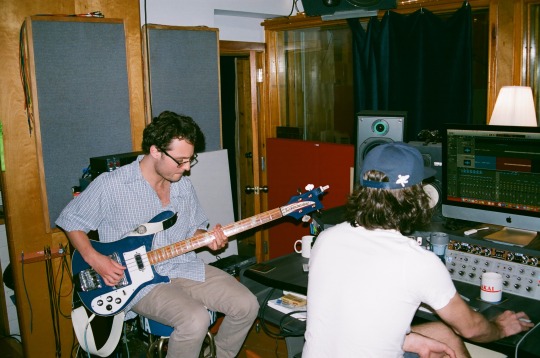
Rob Falcone on bass guitar.
Matt felt like this time was an opportunity to rebrand. Blonde Otter no longer had to “stick to the costume” of live performing for a moment, and could refocus on the music. The band could be more complex with their vision, and evolve into the rock band they had always wanted to be. For Michael, that’s what “Indie” music is — “transcending and bending Rock genre norms and classifications.” According to Stephen, remote collaboration was one of the reasons why the band was able to successfully experiment with new music. He explained that they had ample time to perfect the album because they were able to listen to what they had recorded for months before actually mixing it.

Matt Falcone on drums.
I received different versions of the album since we first convened on Zoom back in February. One week it was a texted link, the next it was an email, the following a file share, with some songs in final form and other songs nearly complete. Then one magical morning, I received the private Soundcloud playlist with all eleven songs mixed and mastered. To my non-musically inclined ears, every version had been ready to be released. But for the five Blonde Otter guys, they were examining their work, breaking it apart again, then perfecting it. Michael said, “It’s a tight album, the tracks are pretty brief and not repetitive. We play the hook once twice, then play it again. It’s all killer, no filler.” To this fan’s ears, it is definitely all killer.
At one point in the interview Matt opened up to the group and shared an intimate confession which is that sometimes he feels like he’s “tweeting to a brick wall” from the Blonde Otter account. They (especially Matt) want and need more followers, and the fans want and need more BO content, so it’s a win-win for everyone. Fair warning, all five BO members have access to the social accounts, so sometimes posts will slip through the cracks before all members can vet them.
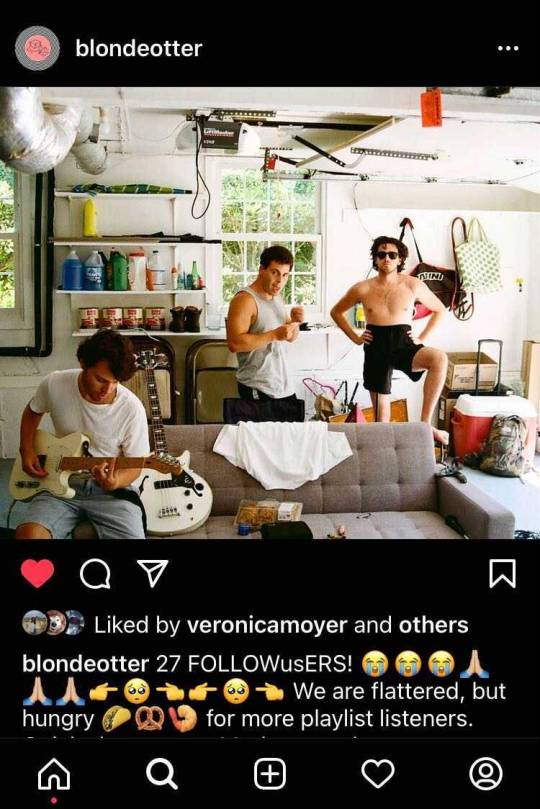
Stephen chimed in saying, “Someone will tweet something and I’ll see it and be like, who the fuck posted this.”
Most of the time, though, these guys are putting a lot of time and effort into crafty posts like this one to engage their fans and loosen up the timeline. To stay up-to-date with all things BO, follow the band on Twitter and Instagram.
Just like the reunion-like performances and the all-nighter after-parties we love to fantasize about one day participating in again, this album drop on April 23rd is something you don’t want to miss. More than anything, you don’t want to be that person in the crowd at the first Blonde Otter concert, post-Covid, not knowing the words to their songs. I know I’ll be feeling like a rockstar whenever the time comes when I get to tell my Connecticut friends that I’m going to a Blonde Otter concert. And this time, the band actually knows who I am. It adds a whole nother level of cool.
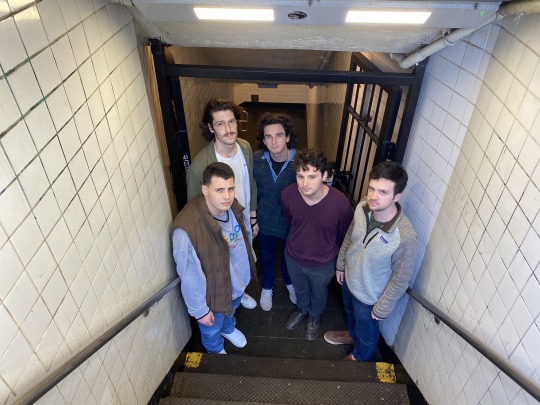
1 note
·
View note
Text
The 30 Day Challenge Each Zodiac Sign Needs To Take In Order To Live Beautifully
Aries: Watch a movie each day challenge
Netflix is great, but how about expanding your knowledge and inspiration for the next 30 days with a movie marathon? A friend of mine took this challenge while he was studying to become an actor and spent a couple minutes each morning reviewing the film he watched the night before.
This proved an excellent exercise to access not only great art, but also to nurture his curiosity, to enhance his thinking and to learn amazing pick-up lines (my point exactly).
Make a list of the films you’ve always wanted to watch and never had the chance to, subscribe to local cinemas to stay informed about premieres or offer to host some movie nights at your place for your friends and their cinema aficionado acquaintances. Soon enough, you’ll have a complete new agenda to look up to!
Taurus: Living without social media challenge
This social media thing has invaded your life, hasn’t it, Taurus? You spend your minutes before falling asleep with your phone rather than with your SO, endlessly scrolling newsfeeds and hopelessly spying on your current Instagram obsessions. Before superficially sighing again and letting your ennui grow stronger than your sense of humour, consider cutting your own access to social channels for one month. Wait, what, you work there? That doesn’t mean you can’t still do it. Create a separate Facebook profile (without adding ANY friends) if you need one for your work, and deactivate your main profile instead. Oh, I know, you think you’re gonna die without your newsfeed tabloid each day, but whenever you postpone going to the toilet in the morning because you want some extra time spying your ex on Facebook, remember your bladder is not an infinite well. Other than that, you’ll be surprised how much spare time you will have access to. You might even want to pass this to your social media obsessed friend(s) next time their lunch gets cold because they HAD to Instagram it.
Gemini: Dance class challenge
This is a good time to work on your feminine/masculine balance and what better way to do so other than dancing your demons away while learning to actually synch with a partner? Takes two to tango, Gemini, and even if you do it just for you to learn to move your hips like Shakira, you can bet this kind of energy will make peace between your conflicted sides.
Cancer: Slow cooking challenge
If your diet’s been more vodka on the rocks and preheated meals this winter, Cancer, you might consider breaking up with your fast foodie knack and get yourself prepared a real, delicious and healthy snack. Even if you’ll find it boring and painstaking in the first week to actually move your ass to the market, analyze recipes and ingredients, spend time figuring how to mix organic avocados with goat cheese and chutney, doing so will make room for creativity in the kitchen. Plus, your body will thank you for that. From all its pores.
Leo: Learning a new skill challenge
It only takes 20 hours to become pretty good at something new. That means 45 minutes each day for a month, and a realistic plan to get you closer to your next dream job, fruition of a hobby or take-off of a business you’ve been long musing to kickstart. You might be surprised how fast your mind wraps itself around this new outlook and you’ll feel so much confident when you’ve touched first base with something you’ve always wanted to do but never considered yourself competent enough to actually do it. Now it’s the time!
Virgo: Deep cleansing challenge
Rest, eat, meditate, repeat. If you’ve been struggling with a difficult project, ran the mile to burnout at work or postponed washing your hair for a whole week (OR, even worse, slept in your make-up because you once read Kim Kardashian gets away with that – which she totally doesn’t, BTW), it’s high time to put a hold on your FOMO and workaholic inside and get a good and completely deserved rest. This means 9 hours of sleep each night, drinking lemon water each morning on an empty stomach, comforting your body with Swedish massage and eating healthy and vitamin reach meals three times a day, no exception. You might also want to swipe alcohol and caffeine while you’re at it, and treat your body and mind the well deserved rest it needs.
Libra: Vippassana meditation challenge
For someone who finds it hard to sit down with their own issues and often forgets to shush and listen to others, a no-talking yoga camp with long meditation classes in the morning and spiritual engaging activities throughout the day may be a winning challenge to finally connect with your deepest desires.
Scorpio: Arts and crafts challenge
The creative adult is the child who survived. If you’ve been feeling disconnected from your heart’s wishes and feel like your anxiety is the only thing standing between you and that big dream of yours, this is a good time to actively listen to your inner child, inner artist, inner voice, and give them some credit. Take a painting class, start scribbling your thoughts into poems, play with clay or take a graphic design course. Whenever I tell myself I can’t do anything artistic because I lack the skill, I think of my friend who channelled her creative energy into 38 paintings over the course of 30 days (!) after she fell in love. And even if you’re not in love, you might end up learning an important lesson about what you really love in life.
Sagittarius: Yoga mat challenge
Your body is a wonderland of sensations, Sag, and you need to work on your flexibility, especially if you want things to get wilder in the bedroom. Your epicurean spirit may find great comfort in taking a relaxing yoga class, while your body will thank you for releasing the blocked energies in your chakras. Take a deep breath and stick to it for one month, even if it seems pointless in the beginning, you will be surprised by your Jagger moves after this!
Capricorn: Be a tourist in your own city challenge
I know, we all love to travel and we get this fantastic high when we’re mingling with new people in different cultures. Then, back home, we find ourselves numbed and bored by the lacklustre of the city we inhabit, often forgetting the myriad of possibilities and attractions that make it so catchy for tourists each season after all. Take some time to sit with your mood while revisiting all the shows, galleries, museums and free activities your city has to offer. Rent a bike and explore the lesser known areas of your city. Book a nice dinner to a venue you’ve never stepped into before. Wear those beautiful clothes that you only sport on holidays (because you feel it’s tacky to dress nice for no occasion) and plan some getaways to local events with your close friends. You will feel tired but extremely happy and thankful for the energy boost your social life and your mind will get from this.
Aquarius: Surf camp challenge
Your body craves interactive sports that help you tone that beach body and boost your adrenaline in the same time. Take a month to relax and refresh your system while learning to surf with a hot instructor in a breezy resort. Lena Dunham just took one on the premiere episode of GIRLS’ season 6 and it made up for some good old soul searching too. Don’t forget to SPF!
Pisces: Diary of dreams challenge
This is a fantastic way to connect to your subconscious and learn decoding the messages it sends to you while you’re resting between the sheets. If you’ve been having nightmares, or if you’re simply curious how your dream world relates to events in your waking life, you might start a dream journal. Get yourself a beautiful notebook and begin collecting your dreams each morning before breakfast, trying to be as explicit and detailed as possible. Reflect on the notes you made at the end of each week and soon you will be able to deconstruct your subconscious mind and connect in surprising ways to the aspects of your life that need improvement.
#life#travel#astrology#zodiac#aries#leo#sagittarius#capricorn#pieces#libra#aquarius#cancer#scorpio#gemini#taurus#virgo#beautiful#sun sign
213 notes
·
View notes
Text
Best Method To Can You See Who Viewed Your Instagram Video Free Of Cost
It is lovely obvious to incredulity who is looking at your profile, stalking your page, or viewing your posts (especially if they chose not to hit the subsequent to button). For those of us similar to our lives documented on social media, its hard not to vibes self-conscious virtually who is looking at our photos and videos online who viewed my Instagram. If youve tried to figure out who viewed your Instagram, you are definitely not alone. Many users are keen can you see who views your instagram story very nearly the order of aficionado and taking into consideration lists, likes, and checking account views, as it is usually determined that the order is not chronological. The precise bill for the order of these lists is not utterly clear, but we know that it every goes back to the Instagram algorithm.
Who Views My Instagram
In short, no. If someone visits your Instagram profile without liking or commenting upon anything, they leave no hint that theyve been there. There are theories that the Instagram algorithm lists the order of Instagram likes and partners based upon stalkers, but ultimately you cant tell who viewed your Instagram. Instagram tally Views. even if you cannot look who views your profile or individual posts, you can look who views your Instagram stories. Stories were added to Instagram in 2016, and have back become wildly popular, surpassing the usage of the native story-sharing app by can I look who viewed my Instagram? Snapchat. If someone views your story, which is forlorn shared for 24 hours, you can say by checking the list of viewers. Instagram savings account Views Order. Now that you know who has viewed your story, you may be wondering what the order of that list means. Many users are interested about the order of fan and subsequently lists, likes, and checking account views, as it is usually distinct that the order is not chronological. The truthful can you see who views your instagram videos description for the order of these lists is not no question clear, but we know that it every goes encourage to the Instagram algorithm. who you engage in the manner of the most upon Instagram will likely appear at the summit of the list, which is why you often look your closest friends or associates as the first spectators upon the list. Who Stalking My Instagram? correspondingly you cant see definitively who visits your Instagram profile, but is there a pretension to figure out your stalkers? Sadly, next no although there is more room for comments upon this question.See who views your Instagram bearing in mind the encourage of Instagram algorithm shows you posts and orders your can you see who views your instagram story cronies and likes based upon three factors: your interests, your relationships, and reference. By interests we objective what you similar to and engage with. association refers moreover to whos content you as soon as and engage with, but with who likes and engages taking into account you. This means that it could broadcast who is stalking you. If someone is always the first like listed upon your photos and you dont regularly interact next them online, they may be an Instagram stalker.
Get This Description
Various apps have claimed to space who has viewed your Instagram or who your stalkers are on social media. Unfortunately, these apps are falsely advertising themselves. The Instagram API (application programming interface) does not allow other apps to permission that information, and Instagram itself does not forgiveness the instruction to users. Any app that says theyll tune who views your profile is lying. even if this respond is somewhat disappointing, take it as a sign to chill out and unplug. Social media already leads to FOMO, self-esteem issues, and paranoia higher than who likes or doesnt afterward your content and why. Its probably a good issue that we cant also obsess exceeding all profile or make known view. Besides, now you can stalk freely without painful not quite anyone noticing. To check who viewed your story, click your profile characterize in the top left corner of your feed or upon your profile. At the bottom left corner of your screen, click Seen By ### to view the list of users who have watched your savings account by who viewed my Instagram. see Instagram bill viewers. Instagrams algorithm, and hence the order of story views, is based on who you interact gone the most online. Instagram assumes that those you interact later than the most incorporation you the most, and they desire to keep you avid and spending era upon their app. The users should bend their Instagram privacy settings. If youre how to see who views your instagram in point of fact anxious nearly who is viewing your Instagram, you can alter your privacy settings as a result that only those youve approved can look your posts. If your Instagram is set to public, anyone can view your posts and stories unless youve blocked someone specifically.Going private on Instagram can negatively impact engagement, as your posts wont be visible to anyone who doesnt follow you already. in imitation of your Instagram set to private you yet wont know which of your buddies is stalking you, but at least youll know that strangers cant see at your photos. Insights reveals how many people have viewed your posts and breaks all along demographics gone age, gender, and location of followers. Check out how many impressions were made upon each post, as well as how many people liked, commented, shared, or saved it. even though you cant see which specific partners viewed your profile or each post, you can look the numbers to augmented gauge your accomplish on Instagram and use that guidance to count up inclusion and get Instagram followers. Many users are interested not quite the order of devotee and next lists, likes, and savings account views, as it is usually distinct that the order is not chronological. The correct report for the order of these lists is not certainly clear, but we know that it all goes support to the Instagram algorithm.
Review
Follow these easy steps to alter your Instagram privacy settings. If you have a concern account who viewed my instagram upon Instagram look who views your Instagram. Go to your profile and tap the three horizontal lines at the top right corner. Click Settings at the bottom of the side menu. Click Privacy and Security > Account Privacy. Strike the toggle to switch your account from public to private, or from private to public you yet cannot see exactly who views your posts or profile, unfortunately. You can, however, look how many users have viewed your herald through Instagram Insights.
1 note
·
View note
Text
"you've got shampoo on your nose."
whatever thoughts i was caught up in are swept away by the feeling of preston's index finger making a swift sweep down the bridge of my nose, giving me a swift boop at the tip before working the small bit into his own hair and rinsing it out under the spray of water a moment later. "what's on your noodle?"
"currently, the fact that you just used the word noodle. now, the noodle dance from the vastly underrated playhouse disney show, pb&j otter. pb&j sandwiches, the fact that brady barton would literally die if he ate a peanut butter and jelly sandwich, the fact that i'd totally risk it for the sweet, sweet taste of a childhood lunchbox fave - besides, i blew out twenty-six candles this year, it is all downhill from here. ooh, new found glory, obscure mid-2000s pop punk bands..."
my thoughts trail off there, caught on the look on preston's face. he never ceases to somehow be bewildered, annoyed, and amused at the exact same time.
"okay, so what were you thinking about, like, before all that?"
less exciting. "weddings."
his face contorts into a less than thrilled expression, a screwy mouth and furrowed eyebrows. i could kiss his whole face, but he sticks his head under the water, somehow managing to keep the conversation going all the while. "like, plural?"
sighing, i bump him aside with my hip so i can rinse my hair. his fingers find their way to my scalp as i speak. "just the one. the bear's, you know."
the bear is teddy graham (hand to god, actual name), best friend second only to preston raimi, and she's currently two months out from the wedding she's been highkey planning since we were in the third grade. which is impressive in and of itself, really, since she didn't meet the groom-to-be until our freshman year at princeton ("where the princes go!" she had declared with a cheery laugh, sweeping us both in a hug when we got our acceptance letters senior year - so her favorite movie was a cinderella story, whose wasn't?) when he was the junior t.a. in the psych class that i did nothing more than sleep through. frankly, the groom-to-be was more of a colorform than anything else. just stick him into the already formed picture and they were all set.
they were also nauseatingly cute and in love and he wasn’t some horrible cheating swamp thing like her old boyfriend and i was also the maid of honor and it was also. just. a lot.
before you're worried, i was only the maid of honor by title alone. our friend cait, who actually had a head on her shoulders and knew how to buy a day planner and use it for more than the first three days, was in charge of making sure everything actually fell into place like it was supposed to. thank god.
“is this, like, a fomo situation?” he didn’t say it, but i could just hear the silent ‘please say no please say no’ that followed the question.
i looked at him like he’d just popped the cap off the shampoo bottle and swallowed it whole. “are you high? all i hear from my mom’s friends is ‘mijaaaaaaa, when are you getting maaarrrrriiiieeeeeed?’ do you seriously think i want to give them the satisfaction?”
he’s holding his hands up in surrender, but i see the twitch of an amused smile quirking at his lips, and i know he’s thinking about just how damn lucky he is to be stuck with me.
second only to being asked when i’m going to get married (okay, third, because then it’s something about when i’m going to bring honor to my whole family with offspring — which is never, but thanks for asking!) is being asked about preston, as if they haven’t all known him since he was eight years old and trying to sit in on my dad’s poker games with his go fish deck, claiming he “knew a thing or two about cards.”
they wanted to know about our relationship, about how long we’d been together, (we weren’t) when we were getting married (we weren’t), when we were having kids (we weren’t), and why the answers to the last three questions weren’t what they’d expected to hear.
and that’s the thing. preston is my best friend. it’s something i’ll deny every time he asks me, even if he knows it’s true all the way down to the very core of his being (he doesn’t even care that he knows it, he still just likes to be smug about it). and because preston is my best friend, it was also our great idea to be all of each other’s terrible firsts so that we could get them all out of the way.
and yes. yes, i do mean every single terrible first.
i forced him to ask me on a date when we were thirteen and then feigned surprise when he actually went through with it. we kissed under the big oak tree in his backyard when we were fourteen and he jammed his tongue so far into my mouth that i slammed my knee straight into his stomach. after extensive googling at the age of fifteen, i decided i was definitely ready to suck a dick and tried and failed and gagged and tried again and the process torturously repeated itself. at sixteen, he returned the favor (sans the dick) and dove under my sheets and i gave him a black eye because apparently i’m more ticklish than i anticipated.
and finally, at seventeen, the doozy. the big kahuna. as you can probably infer based on previous experiences, it was less than perfect. the power knocked out halfway through from a storm outside, it was over in less than thirty seconds, i forgot my dog was in the room and he jumped up in bed with us. it ended with laughing, with us high-fiving like losers as if we’d actually accomplished anything. and then we tried again.
at eighteen, the night of our high school graduation, i made him get a tiny deer tattooed onto his hip bone. a doe, so i’d be stuck with him forever. no backsies. his response was to make me get PRE$$ HERE in his own handwriting on mine in return, a tribute to when he used to only write his name as PRE$TON between grade six and nine.
so. yeah. in a lot of ways, or maybe in all the ways, preston was my person, and i was his. which brought us into each other’s beds, and showers, and kitchen tables, and hallway floors, and couches, and… okay everywhere a lot, but it never brought us to anything that would scream DATING.
just friends who have keys to each other’s apartments and, when there’s nobody better to do, fuck. easy peasy.
my thoughts remain stagnant for a moment as preston’s fingers work out the rest of my shampoo and i step back out so that i’m facing him and he’s grabbing for the conditioner bottle. “okay, so what about the wedding, exactly?”
“sex.”
he blinks back at me. “…as one does.”
“no, seriously. think about it.” i grab the conditioner bottle from him and squeeze some into the palm of my hand, lathering it between my fingers for a moment and working it into my hair. “eventually, like, sometimes, when you get married — that’s it. that’s the last person you’re ever going to have sex with. Isn’t that sad?”
he’s blinking at me like he’s wondering if maybe i’m not serious, but obviously i am, of course i am. it’s SAD.
“do you think teddy knows that?” i prattle on. “should i tell her?”
he actually laughs out this point. “no, oh my god.”
“right,” i purse my lips, hand on my hip. “she’ll have to figure it out eventually.” i lean against the shower wall, shaking my head. “i just can’t imagine being with one person for the rest of my life. like just one person. what if they suck at sex? what if it’s not even good dick, and you married it?”
preston leans back to rinse out his hair, blinking back over at me as he straightens his stance. “so, you’re saying that even if it was really good sex, it’s still not worth being the only sex?”
“no,” i say flatly, arms crossed and leaning back against the wall. “i mean… no. i don’t think so. the idea of one person being the only person in my life forever is fucking horrifying enough as it is.” i pause, blinking back at him and tucking a finger under his chin. “‘cept you.”
preston actually blushes at that, but he covers it up quickly, responding by getting his hands at my hips, my back pressed to the wall. i feel that same dumbass thrill i still always get, the same thrum in my veins, twist in my stomach. “oh, that so?”
i grin, accomplished. “well, i mean, yeah. you’re the only person i really plan on being with me ’til i’m drooling into a cup and senile.”
“so that you can bully me and blaming it on old age.”
i kiss the tip of his nose. “precisely.”
he’s kissing my neck, then. slow and lazy and familiar. i walk him toward the showerhead so that i can rinse my hair, getting him caught under the water in the process, and i keep him there, arms around his neck, fingers scratching at his scalp.
we stay there until the water runs cold.
1 note
·
View note
Text
Venture Capital Due Diligence: Does Outsourcing Work for the Desired Moonshot?
Introduction
The business of Venture Capital funds depends on the targets it invests in. The more the chances of its portfolio companies hitting a moonshot, the more successful the fund is in general. Venture Capital Due Diligence is a process that ensures the appropriate targets are locked in at the seed or early stage to ensure 50-1000X returns in a 5 to 10-year horizon.
The way a VC fund looks at a target is fundamentally different from how a Private Equity or a lender would look at it. A VC fund looks for that one silver lining that can make a portfolio company a roaring success. PE firms mostly weigh pros and cons and generally invest if the Pros outweigh the cons. A lender analyzes if anything at all could go wrong with the company and may jeopardize its investments. Different objectives of investment require different lenses for analysis.
Challenges regarding Venture Capital Due Diligence
VC firms invest in small firms, primarily start-ups, often only at the idea stage. The biggest challenge for due diligence, in this case, is the availability of data. When the idea has not shown any traction, the research needs to be more outside-in. That is finding out the market information and if any customers may be willing to pay for such services of the potential portfolio company. If there is any traction, then the analysis needs to be both outside-in and inside-out. An inside-out investigation is more towards getting into the details related to the operations and finance of the company along with the opportunity that the market offers.
Another challenge is to keep the deal pipeline active for multiple due diligence exercises to happen. Due diligence can throw numerous red flags. If there are various deals in the pipeline, a VC fund can walk away from the opportunity till they get into the company that justifies investment in terms of money and time. Many VC funds park small amounts with the companies they know or are from their circle of friends and family. That biased approach would result in sub-optimal results in the long run. Deals found from networks or events are usually the hot deals that others are also evaluating. That leads to FOMO (Fear of Missing Out) on the part of VCs and hence the overvalued assets.
Advantages of Outsourcing Venture Capital Due Diligence
The advantages the outsourcing brings are numerous like it saves costs, resources are available on-demand and there is a certain specialization with the vendor who works with multiple VC firms, which raises your own investing game.
However, when it comes to outsourcing, there is always a lingering threat in the minds of asset managers. Will the quality be any good? Or what if the deal gets outed due to many individuals knowing about it? Or do they even understand it, ours is anyway a specialized investing or a niche industry?
Challenges around Venture Capital Due Diligence Outsourcing
It is easy to make a business case for outsourcing on an excel sheet, where it can produce 30-70% cost savings while in most cases improving the quality of due diligence. However, concluding everything is hunky-dory with outsourcing is far-fetched. Here are the top challenges with outsourcing venture capital due diligence
There are way too many generalist research and outsourcing players out there, who offer to do research, list generation, and make company profiles, but most of them lack a deep understanding of how VC investing works. There are very few specialist VC research players. Magistral is one of them
VC itself is a new and upcoming industry. In the US alone in the first 8 months of 2021, the number of unicorns created has crossed the number of unicorns ever created in the history of VC investing. That is the acceleration. Though outsourcing provides the access to talent that can deliver, you can be assured the talent itself is half baked, purely due to the massive acceleration that this industry is witnessing
Even the outsourcing home country is witnessing the talent crunch. For example, India itself lacks VC talent and there is a huge demand for trained resources. In a typical FTE-based outsourcing model, it is very possible that you train someone offshore in your diligence processes and he is poached by the competition, leading you to train offsite resources again and again and again. It’s a massive headache
VC investing is more of an art than an exact science and some of the DNA of VC investing is very difficult to outsource.
Magistral’s proprietary process aims to do away with the shortcomings related to Venture Capital due diligence research outsourcing.
Before we dive into the Magistral’s process, here is how we evaluate targets. The things that we analyze closely to ensure the target you invest in has the best chance of becoming your next moonshot and increasing the profile of your fund
Magistral’s Process to Outsource Venture Capital Due Diligence
Venture Capital Due Diligence: Key Components
Venture capital due diligence involves looking specifically around the following aspects of a potential portfolio company before committing to investing:
The opportunity size
Assessing the opportunity size carefully gives an idea of whether there is a possibility of a moonshot with the investment. If the total addressable market (TAM) runs into billions and the company solves an acute pain or saves cost or saves time, or makes the process easier, then there is a massive chance that the company will scale up faster. Sometimes the addressable market is at the conjunction of two or more big markets, and there the TAM needs to be arrived at, with careful triangulation and estimates. Calculation of TAM carefully gives an idea of the upside possible if the strategy and team are right.
Strategy
The opportunity size almost always coincides with the Go to Market (GTM) strategy. This is where lots of VCs add value with their network and connections along with the domain experience. The company suggests a GTM, which experts in the due diligence phase verify. A well-presented GTM has level 2 and level 3 steps, along with the timelines and business outcomes. There is also the requirement of funds laid out clearly for every stage.
The size of the opportunity and how the company plans to seize that opportunity is almost a make-or-break part of the due diligence process.
Competition
Competition sometimes is assuring and occasionally threatening. Competitive intelligence in itself throws light on multiple possibilities. If it’s a product or service promised to be one of its kind, it will be challenging to find an exact competition. The task is not to find the competition per se but carefully checking if the market makes sense, to begin with. Is it just too tricky a market to crack, or is there no market at all, or it’s a service or product no one wants to pay for? Competition or absence of it here is a great pointer. In moderately accepted business models, the company is expected to face competition, big or small. The competition is studied for traction. If all the competition out there is growing at a healthy pace, it shows that the industry may have a place for someone who could do the job better. If competition is shutting shops or taking too long to be profitable, then also it’s a pointer towards the choppy waters ahead.
This also needs to be seen in the light whether the target can be number 1 or 2 in a vast market as it all works on the “winner takes it all” philosophy with VC investing
In any scenario, a careful evaluation of the competition throws a guiding light and is an essential step in the due diligence process
ESG
ESG has picked up in the recent past and for a reason. ESG stands for Environmental, Social, and Governance aspects of an investment that indicates sustainable investing. Though it’s far more critical towards the later stage funding rounds, planning yields rewards in the earlier rounds too. It is estimated that the majority of the deals in the future will be impact or sustainable investments, which will fulfill the criteria of ESG maturity. Some studies show almost all investments would be impact investments a few decades down the line. A VC not only plans for an exit from the portfolio but to raise following funding rounds too. Chances of raising rounds at higher valuation increase if the company is primed to be an ESG investment right from the seed or early-stage rounds.
Financials
If the company has been around for a few years and has seen some traction, financial analysis becomes crucial as any other factor in the due diligence process. Financials feed into the valuation of the company. Financials are also essential to forecast future revenues, profitability, and cash flows. In the due diligence process, reasonable estimates are made to project the company’s financial statements for the next five years. That drives the valuation of the company on which the funds are to be raised. In the due diligence process, sometimes, the assumptions made during the preparation of financial models are tested thoroughly. If there is an assumption that may not stand the scrutiny of the financial analyst, it is flagged. If there is a massive impact of an erroneous assumption, this exercise alone could save millions of dollars for the VC investor.
The team
The founding team in a smaller company is the driving force. Suppose the team is experienced, has relevant skills, produced returns for investors in the past, and is motivated to make a difference. In that case, it can be the difference between an investment that reaches out for a moonshot and another one that proves to be a dud. Checking the team’s credentials, experience, qualifications, and connections is an essential aspect of the due diligence process.
Red Flags
Apart from significant aspects discussed earlier, the due diligence team also looks for red flags in the documents submitted by the company seeking investment. It could either be a legal hurdle, financial irregularities, or any other problems with the documentation. Discussing these red flags with the company may well turn out to be fruitful.
Magistral’s proprietary process for Venture Capital Due Diligence
Magistral’s unmatched advantages in VC Due Diligence
Magistral works with multiple VC firms, some one-man companies, and others running a portfolio of hundreds of companies or start-ups with a few unicorns and soonicorns. After performing hundreds of due diligence exercises across industries like SaaS, healthcare, Tech, Industrials, Services, Real Estate, and others, Magistral has developed a proprietary due diligence service delivery method that counters almost all the drawbacks of outsourcing.
Magistral’s financial analysts take control of the data room. The VC or the company populates all the documents in the data room. We comb through the records with an eagle eye to spot opportunities or red flags. We have developed a standardized checklist to evaluate all types of documents. All our observations and questions are collected by the VC and discussed with the company. We also prepare a detailed report on the business. The information on the company comes from secondary research, discussions with the industry experts, and our in-house expertise in the area. Finally, Investment Memo or pitch deck crystallizes all the insights. These pitch decks are designed consistently with the global marketing standards of the financial industry.
All FTE-based engagements of Magistral have an ever-evolving Standard Operating Procedure (SOP) document. This helps in standardizing the process irrespective of the personal capability of the analyst working on the project. It also ensures a smooth transitioning in case the trained analyst leaves. There is also a shadow analyst always ready to take on in case the analyst leaves permanently or takes off or holidays. It’s so much like the cockpit of Boeing 747, planned for all eventualities.
Our experience has made us more knowledgeable about VC investing than some of our clients. That helps our clients improve their investing game too. Templates, Systems, and our experience and DNA of VC investing ensure due diligence that meets the global standards of investing at competitive valuations. If it sounds interesting, for a conversation with, drop an inquiry here
About Magistral
Magistral Consulting has helped multiple funds and companies in outsourcing operations activities. It has service offerings for Private Equity, Venture Capital, Family Offices, Investment Banks, Asset Managers, Hedge Funds, Financial Consultants, Real Estate, REITs, RE funds, Corporates and Portfolio companies. Its functional expertise is around Deal origination, Deal Execution, Due Diligence, Financial Modeling, Portfolio Management and Equity Research
For setting up an appointment with a Magistral representative visit www.magistralconsulting.com/contact
About the Author
The Author, Prabhash Choudhary is the CEO of Magistral Consulting and can be reached at [email protected] for any queries or business inquiries.
0 notes
Photo

Why is everyone talking about Clubhouse? Some say it’s FOMO
What is Clubhouse and why is the audio chat app so popular?

Clubhouse, the invitation-only audio chat app, exploded in popularity during the coronavirus pandemic when people could not get together in person – but now the once niche platform has far higher goals.
Launched less than a year ago, Clubhouse – which recently encountered a censorship hiccup in China – is looking to establish itself as the standard-bearer for digital audio.
The concept is simple: Once you are invited to join, you can start or listen to conversations in digital “rooms”, ranging from a major talk by someone famous to a chat within a small group.
No posts, no photos, no videos – just audio. Think of it as live podcasts, with the possibility for listeners to chime in.
To get invited to join Clubhouse, an existing Clubhouse user has to send an invite from their app, which adds to the exclusivity of the “club”.
Facebook founder Mark Zuckerberg cropped up on the platform last week, talking about the technology of the future.
In fact, Clubhouse is so popular that Facebook is now building its own version of the chat app, the New York Times reported on Wednesday, citing people familiar with the matter.
SpaceX and Tesla CEO Elon Musk showed up on Clubhouse late last month to talk about the GameStop trading frenzy.
In Germany, Minister President of Thuringia Bodo Ramelow admitted in a talk on Clubhouse to playing Candy Crush on his phone during online pandemic response meetings with German Chancellor Angela Merkel.
But the app was quickly blocked in China, where unfiltered conversations about normally taboo topics, such as democracy protests in Hong Kong and the mass detention of Muslim Uighurs in Xinjiang, ran afoul of government censors.
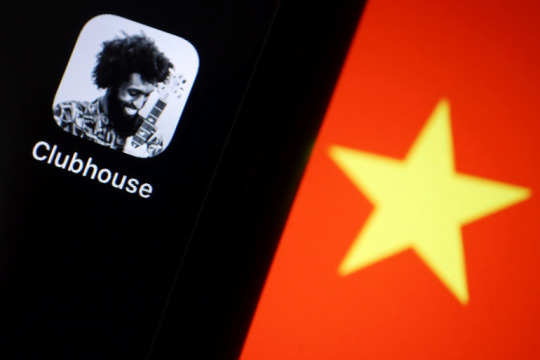
Unfiltered talk on Clubhouse ran afoul of government censors in China, which banned the app
The app, available only on Apple devices, thrives on the concept of FOMO – fear of missing out. If you are not online when a conversation happens, you miss it.
“I was very active in April and May,” says Sheel Mohnot, a California investor with more than a million Clubhouse followers. “And then, you know, you get busy and other stuff was going on. And it’s just hard to make it a priority.”
“But once again, now, I would say, I’m back on pretty regularly,” added Mohnot, who even had a second date on the platform – with two dozen-odd people listening and a psychologist in the background to comment on how it went.
Beyond FOMO, Clubhouse – launched in March 2020 in Silicon Valley for the chosen few, but now used by about two million people every week – thrives on its portability.
Users can walk their dog or cook dinner while listening to talks on financing a start-up or the current state of education – or even tune in while playing trivia games.
Unlike podcasts, everything is live and users can participate – as long as they are invited to do so by chat moderators.
Star-studded user base
A Clubhouse chat can be mundane – but it can also be transformed into a must-hear event if someone famous shows up. In addition to Zuckerberg’s and Musk’s recent appearances, comedian Kevin Hart popped up in a chat last year.
For Musk’s appearance with the boss of trading app Robinhood, the maximum “room” capacity of 5,000 people was quickly reached, so secondary overflow rooms were opened.
“I didn’t get in the room. But someone that had gotten into the room was livestreaming on YouTube,” said Bobby Thakkar, a managing partner at Ampersand Ventures and an early Clubhouse adopter.
In the early days, Thakkar would spend 25 hours a week on Clubhouse, given how little he could go out because of pandemic lockdown measures.
“Everyone knew each other” when Clubhouse first launched, Thakkar told the AFP news agency. Now, he prefers chat rooms where he is just talking with his friends or about topics related to his business.
Mohnot says he is happy that Clubhouse is expanding so quickly.
“Think about it like a podcast, and having more listeners. If you have more listeners, it makes you more excited about doing the podcast,” he told AFP.
Last year, Mohnot participated in all sorts of conversations, including the public second date. He now hosts two weekly shows – one on advances in financial technology and the other on Indian American culture.
At the outset, Clubhouse was criticised for being elitist and not allowing enough users, but some of the initial communities – many of which formed around California investors – are nevertheless still influential.
Simply put, you have to be part of the club.
Audio’s big moment
For David Bchiri, the US director for the consulting firm, Fabernovel, “Clubhouse landed right on time as the platform where people could go vent their thoughts and emotions” about the pandemic and the summer protests against racial injustice in the United States.
The app now must face the usual challenges in the social media world, from how to monetise its popularity to how to pay content creators – to how to moderate that content.
“We now want to open Clubhouse to the whole world,” app founders Paul Davison and Rohan Seth said in late January.
Beyond the apparent problems in China, the app is flying high.
With the backing of more than 180 investors after a new round of fundraising, Clubhouse is valued at about $1bn, according to The Information, a publication for tech executives.
“The last go-round effectively put up a barrier to anyone trying to buy out the company,” Bchiri told AFP, noting that he believes investors are trying to shield Clubhouse from Big Tech.
Clubhouse is nevertheless definitely getting Big Tech’s attention.
Twitter is testing out “Spaces” – audio chat rooms where up to 10 people can talk to an unlimited number of spectators. Facebook is rumoured to be looking at a similar offering.
“We’re in the audio era,” says Bchiri.
“Our grandchildren will never have keyboards. They won’t need to interact with machines in that way. Everything will be done with voice commands or simply by thinking about a task.”
Read full article: https://expatimes.com/?p=17999&feed_id=33273
0 notes
Text
Imagining our alternate selves can be fuel for fantasy or fodder for regret. Most of us aren’t haunted so acutely by the people we might have been. But, perhaps for a morning or a month, our lives can still thrum with the knowledge that it could have been otherwise.
“The thought that I might have become someone else is so bland that dwelling on it sometimes seems fatuous,” the literary scholar Andrew H. Miller writes, in “On Not Being Someone Else: Tales of Our Unled Lives” (Harvard). Still, phrased the right way, the thought has an insistent, uncanny magnetism. Miller’s book is, among other things, a compendium of expressions of wonder over what might have been. Miller quotes Clifford Geertz, who, in “The Interpretation of Cultures,” wrote that “one of the most significant facts about us may finally be that we all begin with the natural equipment to live a thousand kinds of life but end in the end having lived only one.” He cites the critic William Empson: “There is more in the child than any man has been able to keep.” We have unlived lives for all sorts of reasons: because we make choices; because society constrains us; because events force our hand; most of all, because we are singular individuals, becoming more so with time. “While growth realizes, it narrows,” Miller writes. “Plural possibilities simmer down.” This is painful, but it’s an odd kind of pain—hypothetical, paradoxical. Even as we regret who we haven’t become, we value who we are. We seem to find meaning in what’s never happened. Our self-portraits use a lot of negative space.
“You may find yourself in a beautiful house, with a beautiful wife,” David Byrne sings, in the Talking Heads song “Once in a Lifetime.” “And you may ask yourself, ‘Well, how did I get here?’ ” Maybe you feel suddenly pushed around by your life, and wonder if you could have willed it into a different shape. Perhaps you suddenly remember, as Hilary Mantel did, that you have another self “filed in a drawer of your consciousness, like a short story that wouldn’t work after the opening lines.” Today, your life is irritating, like an ill-fitting garment; you can’t forget it’s there. “You may tell yourself, ‘This is not my beautiful house. . . . This is not my beautiful wife,’ ” Byrne sings. Swept up in our real lives, we quickly forget about the unreal ones. Still, there will be moments when, for good or for ill, we feel confronted by our unrealized possibilities; they may even, through their persistence, shape us. Practitioners of mindfulness tell us that we should look away, returning our gaze to the actual, the here and now. But we might have the opposite impulse, as Miller does. He wants us to wander in the hall of mirrors—to let our imagined selves “linger longer and say more.” What can our unreal selves say about our real ones?
It’s likely, Miller thinks, that capitalism, “with its isolation of individuals and its accelerating generation of choices and chances,” has increased the number of our unlived lives. “The elevation of choice as an absolute good, the experience of chance as a strange affront, the increasing number of exciting, stultifying decisions we must make, the review of the past to improve future outcomes”—all these “feed the people we’re not.” Advertisers sell us things by getting us to imagine better versions of ourselves, even though there’s only one life to live: it’s “yolo + fomo,” a friend tells Miller, summing up the situation nicely. The nature of work deepens the problem. “Unlike the agricultural and industrial societies that preceded it,” Miller writes, our “professional society” is “made up of specialized careers, ladders of achievement.” You make your choice, forgoing others: year by year, you “clamber up into your future,” thinking back on the ladders unclimbed.
Historic events generate unlived lives. Years from now, we may wonder where we would be if the coronavirus pandemic hadn’t shifted us onto new courses. Sometimes we can see another life opening out to one side, like a freeway exit. Miller recounts the sad history of Jack and Ennis, the cowboys in Annie Proulx’s story “Brokeback Mountain,” who are in love but live in Wyoming in the nineteen-sixties and seventies, and so must hide it. They disagree about how to understand their predicament. Ennis has no “serious hard feelings,” Proulx tells us. “Just a vague sense of getting short-changed.” But Jack, Miller writes, “is haunted by the lives they might have led together, running a little ranch or living in Mexico, somewhere away from civilization and its systematic and personal violence.” Jack tells Ennis, “We could a had a good life together, a fuckin real good life.” The existence he has is spoiled by the one he doesn’t.
It makes sense for Jack to dwell on how things might have turned out in a better world. And yet we can have the same kinds of thoughts even when we’re basically happy with our lives. The philosopher Charles Taylor, who has written much about the history of selfhood, has a theory about why we can’t just accept the way things are: he thinks that sometime toward the end of the eighteenth century two big trends in our self-understanding converged. We learned to think of ourselves as “deep” individuals, with hidden wellsprings of feeling and talent that we owed it to ourselves to find. At the same time, we came to see ourselves objectively—as somewhat interchangeable members of the same species and of a competitive mass society. Subjectivity and objectivity both grew more intense. We came to feel that our lives, pictured from the outside, failed to reflect the vibrancy within.
A whole art form—the novel—has been dedicated to exploring this dynamic. Novelists often show us people who, trapped by circumstances, struggle to live their “real” lives. Such a struggle can be Escher-like; a “real” life is one in which a person no longer yearns to find herself, and yet the work of finding oneself is itself a source of meaning. In Tolstoy’s “Anna Karenina,” Anna, caught in a boring marriage, destroys her life in an attempt to build a more passionate, authentic one with Count Vronsky. All the while, Levin, the novel’s other hero, is so confused about how to live that he longs for the kind of boring, automatic life that Anna left behind. Part of the work of being a modern person seems to be dreaming of alternate lives in which you don’t have to dream of alternate lives. We long to stop longing, but we also wring purpose from that desire.
An “unled” life sounds like one we might wish to lead—shoulda, coulda, woulda. But, while I’m conscious of my unlived lives, I don’t wish to have led one. In fact, as the father of a two-year-old, I find the prospect frightening. In “Midlife: A Philosophical Guide,” the philosopher Kieran Setiya points out that, thanks to the “butterfly effect,” even minor alterations to our pasts would likely have major effects on our presents.
Sartre thought we should focus on what we have done and will do, rather than on what we might have done or could do. He pointed out that we often take too narrow a census of our actions. An artist, he maintains, is not to be “judged solely by his works of art, for a thousand other things also help to define him.” We do more than we give ourselves credit for; our real lives are richer than we think. This is why, if you keep a diary, you may feel more satisfied with the life you live. And yet you may still wonder at the particular shape of that life; all stories have turning points, and it’s hard not to fixate on them.
Miller quotes the poem “Veracruz,” by George Stanley, in full. It opens by the sea in Mexico, where Stanley is walking on an esplanade. He thinks of how his father once walked on a similar esplanade in Cuba. Step by step, he imagines alternative lives for his father and for himself. What if his dad had moved to San Francisco and “married / not my mother, but her brother, whom he truly loved”? What if his father had transformed himself into a woman, and Stanley had been the child of his father and his uncle? Maybe he would have been born female, and “grown up in San Francisco as a girl, / a tall, serious girl.” If all that had happened, then today, walking by the sea in Mexico, he might be able to meet a sailor, have an affair, and “give birth at last to my son—the boy / I love.”
“Veracruz” reminds me of the people I know who believe in past lives, and of stories like the one David Lynch tells in “Twin Peaks,” in which people seem to step between alternate lives without knowing it. Such stories satisfy us deeply because they reconcile contrary ideas we have about ourselves and our souls. On the one hand, we understand that we could have turned out any number of ways; we know that we aren’t the only possible versions of ourselves. But, on the other, we feel that there is some fundamental light within us—a filament that burns, with its own special character, from birth to death. We want to think that, whoever we might have been, we would have burned with the same light. At the end of “Veracruz,” the poet comes home to the same son.
As Sartre says, we are who we are. But isn’t the negative space in a portrait part of that portrait? In the sense that our unled lives have been imagined by us, and are part of us, they are real; to know what someone isn’t—what she might have been, what she’s dreamed of being—this is to know someone intimately. When we first meet people, we know them as they are, but, with time, we perceive the auras of possibility that surround them. Miller describes the emotion this experience evokes as “beauty and heartbreak together.”
The novel I think of whenever I have this feeling is Virginia Woolf’s “To the Lighthouse.” Mrs. Ramsay, its central character, is the mother of eight children; the linchpin of her family, she is immersed in the practicalities of her crowded, communal life. Still, even as she attends to the particulars—the morning’s excursion, the evening’s dinner—she senses that they are only placeholders, or handles with which she can grasp something bigger. The details of life seem to her both worthy of attention and somehow arbitrary; the meaning of the whole feels tied up in its elusiveness. One night, she is sitting at dinner, surrounded by her children and her guests. She listens to her husband talking about poetry and philosophy; she watches her children whisper some private joke. (She can’t know that two of them will die: a daughter in childbirth, a son in the First World War.) Then she softens her focus. “She looked at the window in which the candle flames burnt brighter now that the panes were black,” Woolf writes, “and looking at that outside the voices came to her very strangely, as if they were voices at a service in a cathedral.” In this inner quiet, lines of poetry sound:
And all the lives we ever lived and all the lives to be
Are full of trees and changing leaves.
Mrs. Ramsay isn’t quite sure what these lines mean, and doesn’t know if she invented them, has just heard them, or is remembering them. Still, Woolf writes, “like music, the words seemed to be spoken by her own voice, outside her self, saying quite easily and naturally what had been in her mind the whole evening while she said different things.” We all dwell in the here and now; we all have actual selves, actual lives. But what are they? Selves and lives have penumbras and possibilities—that’s what’s unique about them. They are always changing, and so are always new; they refuse to stand still. We live in anticipation of their meaning, which will inevitably exceed what can be known or said. Much must be left unsaid, unseen, unlived.
Excerpt from: Joshua Rothman, ‘What If You Could Do It All Over? The uncanny allure of our unlived lives’, in: The New Yorker (December 14, 2020).
0 notes
Text
FEAR OF MISSING OUT (FOMO)

What Is FOMO?
This is a social anxiety stemmed from the belief that others might be having fun while the person experiencing the anxiety is not present. It is characterized by a desire to stay continually connected with what others are doing. FOMO is also defined as a fear of regret, which may lead to concerns that one might miss an opportunity for social interaction, a novel experience or a profitable investment. It is the fear that deciding not to participate is the wrong choice.
Social networking creates many opportunities for FOMO. While it provides opportunities for social engagement, it offers an endless stream of activities in which any given person is not involved. Psychological dependence on social networks can result in anxiety and can lead to FOMO or even pathological Internet use. FOMO could result from not knowing about a conversation, missing a TV show, not attending a wedding or party, or hearing that others have discovered a new restaurant. The fear of missing out refers to the feeling or perception that others are having more fun, living better lives, or experiencing better things than you are, and involves a deep sense of envy and affects self-esteem. FOMO is also the sense that there might be better things that you could be doing at this moment and involves a sense of helplessness that you are missing out on something big.

Brief History
The idea that you might be missing out on a good time is not new to our era. However, while it has presumably been around for centuries (you can see evidence of FOMO in ancient texts), it has only been studied since 1996. Social media has accelerated the FOMO phenomenon in several ways. It provides a situation in which you are comparing your regular life to the highlights of others' lives. Therefore, your sense of "normal" becomes skewed and you seem to be doing worse than your peers. You might see detailed photos of your friends enjoying fun times without you, which is something that people may not have been so readily aware of in past generations. Social media creates a platform for bragging; it is where things, events, and even happiness itself seems to be in competition at times. People are comparing their best, picture-perfect experiences, which may lead you to wonder what you are lacking.
The roots: FOMO Comes from Unhappiness
Those with low levels of satisfaction of the fundamental needs for competence, autonomy, and relatedness tend towards higher levels of fear of missing out as do those with lower levels of general mood and overall life satisfaction. So you’re not feeling so great — whether you realize it or not — and you turn to social media to make you feel better. Only one problem there: it actually makes you feel worse.
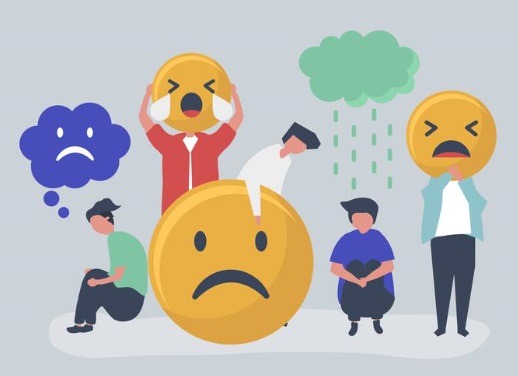
The Attention Deficit
The problem with FOMO is the individuals it impacts are looking outward instead of inward. When you’re so tuned in to the ‘other,’ or the ‘better’ (in your mind), you lose your authentic sense of self. This constant fear of missing out means you are not participating as a real person in your own world. And the key to happiness really comes down to one word - Attention. Your happiness is determined by how you allocate your attention. What you attend to this, it drives your behaviour and it determines your happiness. The scarcity of attentional resources means that you must consider how you can make and facilitate better decisions about what to pay attention to and in what ways. If you are not as happy as you could be, then you must be misallocating your attention. So changing behaviour and enhancing happiness is as much about withdrawing attention from the negative as it is about attending to the positive. People with FOMO stop paying attention to life and turn to social media for their happiness cure.
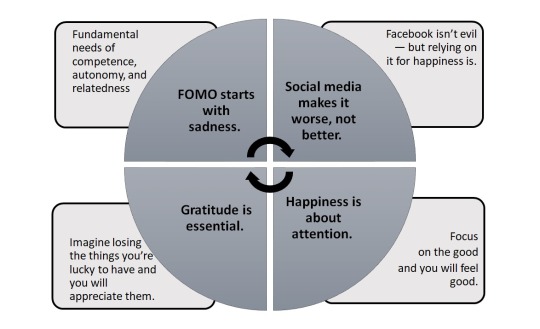
The Social Media Illusion
We all know that Social Media doesn’t provide a very well-rounded picture of people’s lives. Often it seems like if bragging and showing off were banned, some people wouldn’t post anything at all. But despite knowing this, studies say we can’t help but compare our lives to others. If one only wished to be happy, this could be easily accomplished; but we wish to be happier than other people, and this is always difficult, for we believe others to be happier than they are.
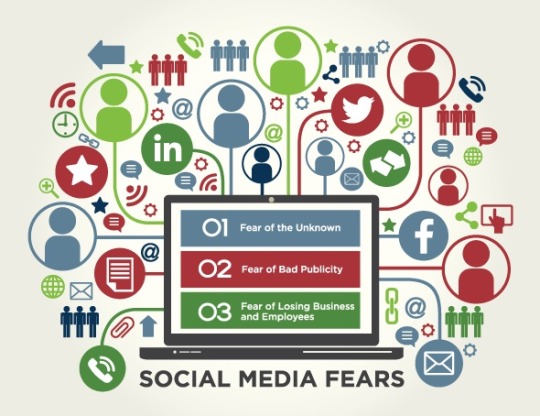
As Erica Jong once said: “Jealousy is all the fun you think they had.” Even if we logically know Social Media isn’t an accurate depiction of people’s lives, well, confronting your seeming inadequacy 24/7 against an unachievable false reality can hammer your already vulnerable self-esteem. But engaging to alleviate your discomfort also has an important secondary effect: by presenting your carefully edited version of life awesomeness, you just made anyone who sees it feel worse. You’re spreading the virus.
1) Social networking sites are both a cause and an effect of FOMO, acting as a mechanism that triggers higher social networking usage. It appears that FOMO is linked to both feeling a need to engage in social media and increasing that engagement, thereby contributing to a negative, self-perpetuating cycle.
2) You may find yourself seeking a greater connection when you are feeling depressed or anxious, and this is healthy. Feelings of loneliness or exclusion are actually our brain's way of telling us that we want to seek out greater connections with others and increase our sense of belonging.
3) FOMO can be experienced by people of all ages. Smartphone usage was related to fears of negative and even positive evaluations by others as well as linked to negative effects on mood.
4) FOMO is linked to lower life satisfaction. Fear of missing out was found to be associated with a lower sense of having one's needs met as well as a lower feeling of life satisfaction in general.
5) Aside from increased feelings of unhappiness, fear of missing out can lead to greater involvement in unhealthy behaviours. FOMO has been linked to distracted driving, which in some cases can be deadly.
Minimizing FOMO
Change your focus.: Rather than focusing on what you lack, try noticing what you have. Add more positive people to your feed; hide people who tend to brag too much or who are not supportive of you. You can change your feed to show you less of what triggers your FOMO and more of what makes you feel good about yourself. Work on identifying what may be sapping your joy online and minimize these as you add more to your feed (and life) that makes you happy.
Keep a journal.: It is common to post on social media to keep a record of the fun things you do. However, you may find yourself noticing a little too much about whether people are validating your experiences online. If this is the case, you may want to take some of your photos and memories offline and keep a personal journal of your best memories, either online or on paper. This can help you to shift your focus from public approval to private appreciation of the things that make your life great. This shift can sometimes help you to get out of the cycle of social media and FOMO.
Seek out real connections.: Rather than trying to connect more with people on social media, why not arrange to meet up with someone in person? Making plans with a good friend, creating a group outing, or doing anything social that gets you out with friends can be a nice change of pace, and it can help you to shake that feeling that you are missing out. Even a direct message on social media to a friend can foster a greater and more intimate connection than posting to all of your friends.
Focus on gratitude.: Studies show that engaging in gratitude-enhancing activities like gratitude journaling or simply telling others what you appreciate about them can lift your spirits as well as those of everyone around you. This is partially because it is harder to feel as if you lack the things you need in life when you are focused on the abundance you already have. The more a person is inclined to gratitude, the less likely he or she is to be depressed, anxious, lonely, envious, or neurotic. And feeling gratitude doesn’t just make you happier. It’s correlated with an objectively better life. Gratitude, controlling for materialism, uniquely predicts all outcomes considered, like a higher grade point average, life satisfaction, social integration, and absorption, as well as lower envy and depression.
Use social media in moderation.: The negative effects of social media often occur when social media is used very frequently, or at the expense of maintaining relationships offline. Social media can be a great tool for connecting with other people. Although we can experience FOMO when we learn about fun events after-the-fact, social media can also be a great way to find out about events we are able to attend. Social media can complement a healthy, fulfilling social life when used in moderation. To reduce your social media use, try using Moment or another activity-tracking smartphone app to monitor the time you spend on social media and set realistic goals for reducing your social media time and replacing it with more fulfilling activities.
Focus on your friends more than your acquaintances.: We can use social media to keep in touch with people who live far away and to see what our friends are doing. Viewing close friends’ posts is less likely to provoke the upward social comparison that harms our well-being than viewing acquaintances’ or strangers’ posts.
Share updates from your own life in a mindful way.: Although we know our own lives aren’t perfect, it’s often tempting to portray them that way on social media. It’s natural to want to present ourselves positively, and updating our own social media accounts can boost our self-esteem. However, occasionally discussing the less-than-perfect aspects of our lives can help others feel connected to us and give them the opportunity to support us. Honesty on social media may also help mitigate the negative consequences of social media use for others.
Content Curated By: Dr Shoury Kuttappa

#fear of missing out#fear#anxiety#social#media#unhappiness#attention#defecit#happiness#gratitude#connection#coordination#cooperation#networking#connected#satisfaction#journal#focus#behaviours#moderation#mindfullness
0 notes
Text
Is Social Media Killing The “Friendship Concept?”
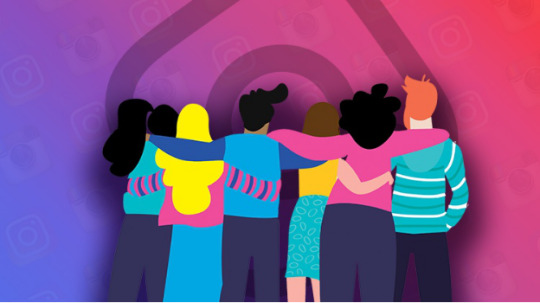
When it comes to social media, there are several positive aspects. For instance, teens can keep up with friends who move away and make connections with others who have similar interests. They can even leverage social media to build a positive online reputation, one that colleges and prospective employers find impressive.
But there are some negative aspects of social media. Aside from cyberbullying, oversharing and sexting issues, social media also can put negative pressure on friendships, especially when one friend is very active about posting pictures, status updates and opinions that hurt others.
Maybe the blue light that illuminates our faces as we scroll through feeds and friends is to blame for disrupting our sleep cycle. Being unrested can explain the grogginess and irritability one has. Or it could be something else.
Maybe, as we tell ourselves that we’re online to stay connected, we’re unknowingly draining our social energy for in-person interactions. What if every like, heart, and reply we give to someone on the internet is taking away from our energy for offline friendships?
There’s a capacity for friendships, even online
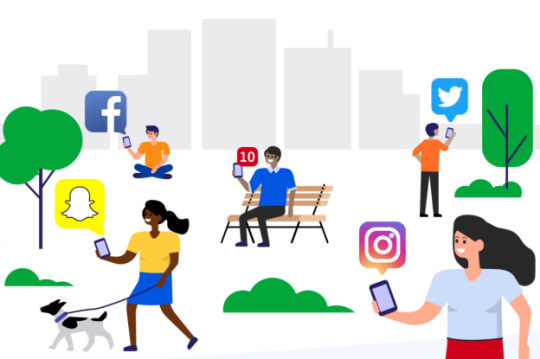
While our brains can tell the difference between chatting online and in-person social interaction, it’s unlikely we’ve developed more or a separate set of energy just for social media use. There’s a limit as to how many people we’re truly in touch with and have the energy for. That even means that the late-night hours spent engaging in conversations with strangers online takes away from the energy we must care for people we know offline.
“It seems we really can only handle about 150 friends, including family members,” says R.I.M. Dunbar, PhD, a professor in the Department of Experimental Psychology at the University of Oxford. He tells Healthline that this “limit is set by the size of our brains.
”According to Dunbar, this is one of the two constraints that determine how many friends we have. Dunbar and other researchers established this by conducting brain scans, finding that the number of friends we have, off and online, is related to the size of our neocortex, the part of the brain that manages relationships.
Nobody is a stranger to deep diving into the Facebook rabbit hole. You know the scenario. According to data from GlobalWebIndex, people are spending an average of more than two hours a day on social media and messaging in 2017. This is half an hour more than in 2012, and likely to increase as time goes on.
“The time you invest in a relationship determines the strength of the relationship,” Dunbar says. But Dunbar’s recent study suggests that even though social media allows us to “break through the glass ceiling” of maintaining offline relationships and have larger social networks, it doesn’t overcome our natural capacity for friendships.
Often, within the 150 limit we have inner circles or layers that require a certain amount of regular interaction to maintain the friendship. Whether that’s grabbing coffee, or at least having some type of back-and-forth conversation. Think about your own social circle and how many of those friends you consider closer than others. Dunbar concludes that each circle requires different amounts of commitment and interaction.
Dunbar says that, just like we do in the face-to-face world, we dedicate the bulk of our interaction on social media to the 15 people closest to us, with about 40 percent of our attention going to our 5 besties and 60 percent to our 15. This ties into one of the oldest arguments in favor of social media: It might not expand the number of true friendships, but these platforms can help us maintain and strengthen our important bonds. “Social media provide a very effective way of keeping old friendships going, so we shouldn’t knock it,” Dunbar says.
One of the perks of social media is being able to engage in the milestones of people I don’t live near. I can be a voyeur of everything from precious moments to mundane meals, all while I go about my own daily routine. But along with the fun, my feeds are also flooded with headlines and heated commentary from my connections and strangers — it’s unavoidable.
There are consequences to your energy levels when engaging in the comments
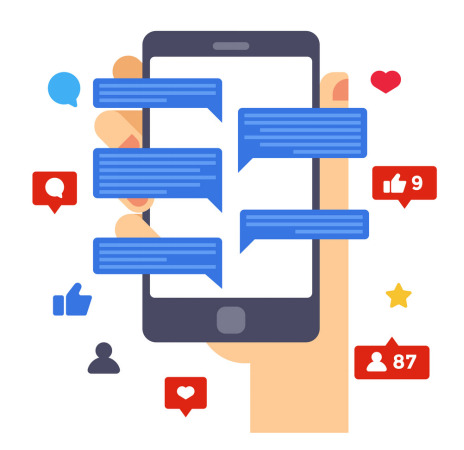
Is engaging a response healthy for me and my friendships?
2017 has been, no doubt, one of the wildest years for online engagement, turning URL conversations into IRL (in real life) consequences. From a moral, political, or ethical debate to confessions of #metoo, we’re often angered or feel pressured to chime in. Especially as more familiar faces and voices join the opposite side. But at what cost to ourselves — and to others?
Facebook’s research team also asked a similar question: Is social media good or bad for our well-being? Their answer was that spending time was bad, but actively interacting was good. “Simply broadcasting status updates wasn’t enough; people had to interact one-on-one with others in their network,” David Ginsberg and Moira Burke, researchers at Facebook, report from their newsroom. They say that “sharing messages, posts, and comments with close friends and reminiscing about past interactions — is linked to improvements in well-being.”
But what happens when these active interactions turn rotten? Even if you don’t unfriend someone over a dispute, the interaction — at the very least — may change your impressions with and of them.
”There is some evidence that people are more willing to punish others when interacting via a computer interface than they are when they interact face to face,” Crockett tells us. Expressing moral outrage can also open up to negative responses in return, and from people who may not have much empathy for different opinions. When it comes to engaging in polarizing conversations, you may want to turn online interactions into offline ones. Crocket mentions “there is also research showing that hearing other people’s voices helps us counteract dehumanization during political debates.”
“Think before you post,” Headlee says. “Before you respond on social media, read the original post at least twice so you’re sure you understand it. Then do a little research on the subject. All of this takes time, so it slows you down, and it also keeps your thoughts in context.”
Autumn Collier, an Atlanta-based social worker who treats patients with social media addiction concerns, agrees. Political posting requires a lot of energy with little return on the investment, she points out. “It may feel empowering at the time, but then you get caught up in ‘Did they reply?’ and engage in an unhealthy back-and-forth dialogue. It would be more meaningful to put that energy into a cause or writing a letter to your local politicians.”
And sometimes, it may just be better to ignore the conversation. Knowing when to step away and go offline can be key for your mental health and maintaining future friendships.
All likes and no play can make a lonely generation
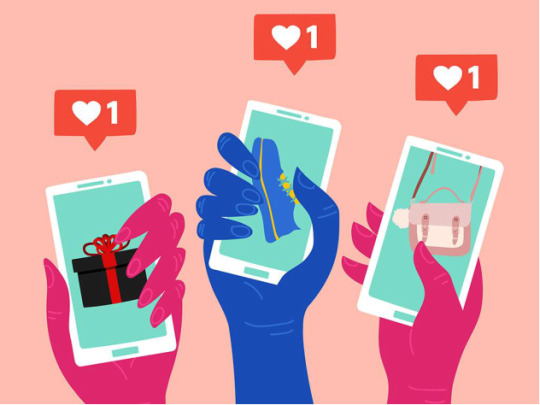
When it comes to staying in touch with friends, it’s also important to know when to engage in face-to-face interaction again. While Dunbar has praised the benefits of social media, there’s also a growing body of research about the negative effects of social media, such as increasing depression, anxiety, and feelings of loneliness. These feelings could be attributed to the number of people you follow and engage with, friends or not.
“Social media advertises itself as increasing our connections to each other, but several studies show that people who spend more time on social media are actually more lonely, not less,” says Jean Twenge, author of “iGen: Why Today’s Super-Connected Kids Are Growing Up Less Rebellious, More Tolerant, Less Happy — and Completely Unprepared for Adulthood.” Her article for The Atlantic, “Have Smartphones Destroyed a Generation?” made waves earlier this year and caused many millennials and postmillennials, to do exactly what can stress people out: Express moral outrage.
FOMO can turn into a vicious cycle of comparison and inaction. Worse, it may cause you to live your “relationships” on social media. Instead of enjoying quality time with friends, significant others, or family, you’re watching stories and Snaps of others with their friends and family. Instead of engaging in the hobbies that bring you happiness, you’re watching others engage in hobbies we wish we could. This activity of “hanging out” on social media can result in neglecting friends in all circles.
Remember Dunbar’s study? If we fail to interact with our favorite people regularly, “the quality of the friendships declines inexorably and precipitously,” he says. “Within a couple of months of not seeing someone, they will have slipped down into the next layer.”
Social media is a new world, and it still needs rules
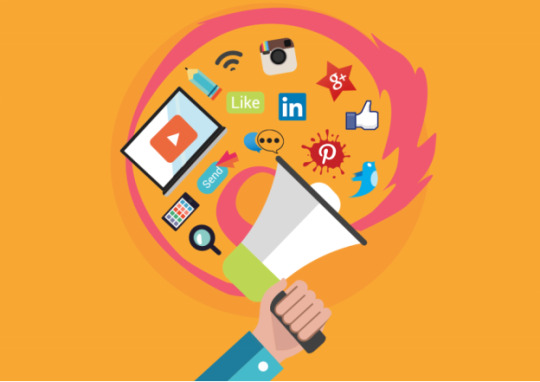
The world is intense right now, even more so when you’re always online. Rather than reading one breaking headline at a time, an average feed will seek our attention with more than enough stories, anything from earthquakes to wholesome dogs to personal accounts. Many of these are also written to trigger our emotions and keep us clicking and scrolling. But there’s no need to be part of it all the time.
Being on your smartphone can drain the energy that could’ve been spent engaging in real-life interactions with your friends or family. Social media is never the prescription for staving off boredom, anxiety, or loneliness. At the end of the day, your favorite people are.
Research shows that good friendships are vital to your health. More specifically, having close friendships correlates to functioning better, especially as we get older. A recent cross-sectional study of over 270,000 adults found that strains from friendship predicted more chronic illnesses. So don’t keep your friends at arm’s length, locked in your phone and DMs.
“Friends exist to provide us with shoulders to cry on when things fall apart,” Dunbar says. “No matter how sympathetic someone may be on Facebook or even Skype, in the end it is having a real shoulder to cry on that makes the difference to our being able to cope.”
0 notes
Text
12 Best Customer Retention Strategies to Increase Repeat Sales
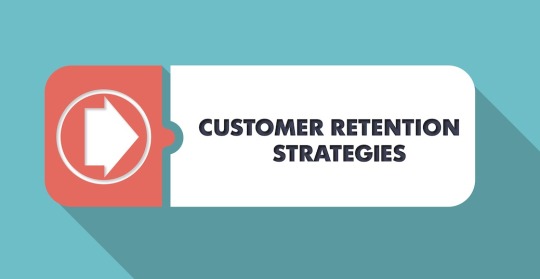
At every stage of your business, you’re required to brainstorm for identifying best customer retention strategies that is compatible to your consumer group.
What’s better than acquiring a new customer?
It may seem like a trick question, but the answer is fairly straightforward – Retaining an existing customer.
In his book, The Loyalty Effect, marketing guru, Fred Reichheld states that “a 5% improvement in customer retention rates yield between 25 to 100 times increase in profits across a wide range of industries.” Marketing automation is one sure shot way for remarketing and maintaining customer relations.
Entrepreneurs swear by this and it’s time you should too! It is also a well-proven fact that keeping customers is far less expensive than acquiring a new customer.
While there’s certainly an allure which comes with acquiring new customers, but it is customer retention which will continually result in a greater ROI. Most importantly – it costs 20-25 times less too!
Before we delve any further into the best practices, let’s acquire a better understanding of what is exactly, customer retention.
What is meant by customer retention?
Customer retention is a bunch of activities a business leverages to increase the number of repeat customers, and consequently, increase the profitability of each existing user.
You must ensure the customers you spent so much marketing and sales cost to acquire stay with you and continue to get value from your products. Thus, customer retention strategies empower you to both provide and extract more value from your existing customer base.
In short, the acquisition creates a basic foundation of customers while your retention strategy helps build customer relationships and most importantly maximize revenue for each one.
But how do you create a customer retention strategy that keeps your current customers engaged and happy?
We’ve broken down twelve customer retention strategies that the biggest tech goliaths and brands are currently utilized to inspire loyalty. From prioritizing personalization to leveraging convenience, below are some simplistic elements which any customer success team and marketer can take and test today.
Listed below are some of the best customer retention strategies which can help your business.
Workflow automation & follow-up emails.
Clues for customer reviews.
Encourage customers to promote their purchase (loyalty program).
Product Recommendations.
Personalizations & Automation.
Personalize email campaign & push notifications.
Refer a friend- offer incentives for shares
Segmentation: know your customer’s mind
Measure customer lifetime value
Abandoned cart notification (email & push).
Empower customers with convenience
AI enabled pop-up (you can give offers, encourage customers for reviews, loyalty, product recommendations, new arrivals).
1. Workflow Automation & Follow-up emails for Customer Loyalty
Email marketing is undoubtedly one of the best ways to drive repeat purchases. It is estimated that people check their emails more than 15 times per day and unlike social media and search engines, they aren’t governed by some fickle algorithms. Hence, your email is certain to be viewed by the customer instead of getting buried by some algorithm. But, it is easier said than done – An average customer receives at most 200 promotional emails every day. So, how do you differentiate yours from the competition?
The trick lies in personalization. BUT DON’T SPAM.
How often you should hit your customers with deals, offers, and updates is hotly debated. Although two and four times per month seems to be the “sweet spot” for most industries (five for eCommerce).
Although, if a customer has just purchased, don’t hesitate in following up regarding their recent purchase. There’s nothing spammy about following up.
The major highlight of email follow-ups is that you can automate them. There are numerous email automation tools out there. In particular, post-purchase emails and autoresponders are an awesome way to bring dormant customers back into the fold.
For instance, wait a week after the initial purchase before following up with an incentive for your customers to leave feedback on site.
It doesn’t matter how you re-engage but make sure you’re keeping your brand on the top of mind for your customer list. The best part – You can easily automate this.
2. Read Customer Reviews for Retargeting Efficiently
It is critical for retaining customers to constantly reiterate your product to meet the customers’ requirement. What better way to know what customers want than asking them in the first place!
No-brainer, right?
To figure out how to grab the attention of customers in the future, look no further than your existing customer feedback. Your customers will give you tips about what’s great about your product and what is something that requires change.
That’s why many companies employ ratings and reviews software to derive insights about their prod
For instance, PowerReviews, provide brands and retailers with the detailed information through review content analysis. Similarly, another tool Product Pulse enlists the top-performing products, but also find the terms and commonly used adjectives in the customer reviews to figure out what’s actually working and causing returns.
3. Customer Loyalty Programs
Consumers today support brands as a part of their own identity.
Sometimes a brand inspires loyalty not through marketing tactics and systems, but through what they stand for.
If you’ve haven’t watched Simon Sinek’s TED talk “Start with Why,” you should. In case you already know a thing or two about the importance of having a mission then you must work hard to implement it.
Everyone wishes to be a part of something bigger than themselves. Thus, framing your product or business as representing a sort of community is a smart move for establishing a stronger sense of brand loyalty.
There couldn’t be a better example to understand brand loyalty than Apple. The tech giant has uniquely positioned itself to create an ever-increasing customer base, by associating themselves to a vision, vis-à-vis, “Challenging the status quo.” In addition, they’ve complemented this loyalty by establishing their own ecosystem, and it is hard to get out of it.
Referral systems can also be an effective way for customer retention when done well. The key is to focus on strong incentives to get people invested in your brand. Besides, don’t forget to empower and encourage your customers to become flag-bearers for your brand in the process.
4. Product Recommendation is a Sales Plan!
Product recommendations accounts for 1/3rd of ecommerce sales.
The takeaway?
Upselling is real and helps increases customers lifetime value. Never miss out on it.
If you want your customers to purchase from your site again, offer a suggestion to make that happen. Amazon’s recommendation engine is a wonderful example of how you can drive repeat purchases based on customers buying patterns.
You can also include product recommendations as part of your follow-up email campaigns.
Important Note: Upselling is a great way to increase revenue and you don’t necessarily need a full-blown recommendation engine to suggest products. Instead what you can do is simply suggest customers check out your latest offers and frame them as recommendations.
5. Personalization & Automation
Personalizing outgoing emails can go a long way in connecting with your customer and retaining the already existing ones. Sometimes, the greatest form of advertising isn’t your own. In fact, customers are more likely to value opinions coming from friends, family, and other consumers more than ads or branded content.
This newer category of advertising is what is termed as social proof advertising. Utilizing testimonials and customer stories from renowned consumers can go a long way to show prospective customers the value of your product.
Give your buyers a VIP treatment. You can devise an exclusive promotional campaign targeting your past buyers. Making your past customers feel special by “only for you” offers and deals will make them feel special and valuable. You’ll be surprised how a little favoritism can go a long way in customer retention.
For example, “for your eyes, only” email deals make being part of your list even more valuable while also encouraging another purchase.
According to a recent Statista Report, more than 60% of customers trust online reviews and witnessing popular individuals and brands use your product actually makes others want to do it more – thus, FOMO is a really good marketing and retention tactic.
6. Push Notifications
Push notifications help in registering the product in the mind of your consumer. According to Jeff Weiner (co-founder LinkedIn), a customer needs to see your product at least seven times in order to create an impression.
Hence, push notifications are a great tool of reminding customers about your brand, new deals, offers, product updates, price drop, etc. They don’t cost much to implement and are normally easy to integrate with your platform. Thus, utilizing it to drive repeat purchases is something you should include in your customer retention strategy.
7. Referral programs
Another great customer retention strategy that has gained tremendous popularity in recent years is the referral programs. Our focus here is on creating a clever referral program where customers are encouraged from the moment, they purchase to refer a friend. This can be achieved only when the rewards are worth it. Thus, you need to come up with a clever referral program which not only incentivizes customers to refer your product but at the same time maintains the bottom-line of your business.
When done well, referral systems can be really effective for retention. The key is to focus on strong incentives to get people invested.
One study concluded that customers acquired by word-of-mouth referrals spend approximately 200% more than the average customer. Another critical aspect to keep in mind is that, once you have a consumer, you don’t want to pay to acquire that customer again as if they were brand new.
8. Segmentation
People crave to have personal connections with the brands they buy from.
There is no “right” way to create that connection, but one way is through supporting a cause. Your specific retention strategy should focus on the needs of your shoppers. Once you’ve figured out that aspect you should please them with campaigns you know they’ll love.
For example, Bombas, an up-and-coming apparel startup designs luxury socks, and for every pair bought of their website, they donate one pair to the homeless. It might seem like a lot for a startup, but last year Bombas surpassed $50 Million in revenue.
Thus, getting inside the mind of your ideal customer persona is crucial to scale up your venture and to retain customers.
Simple interactions do a lot better than you likely think.
Take for instance, how many businesses post a shoutout for their customers, which for most, might seem entirely random or even without a direct mention to a brand.
9. Measure Customers lifetime value
If you don’t realize it till now, then let me make myself very clear – Your customers are your biggest asset.
Customer Lifetime Value is one of the key indicators that depict the worth of your customers over a period.
CLV is especially critical for business which is subscription-based. For instance, if you sell online courses and charge a monthly fee, you’re not really concerned about new customers, but the lifetime value of each customer who purchases from you today.
It takes a lot of resources to get a customer and as an entrepreneur, you’ll likely be curious to know the value each of your customers is bringing to your business. This is called the customer’s equity. Some of your customers might add more value than others. Some always come around to buy. These repeated buyers should be your focus group or VIP customers.
These VIP customers are the same group who will refer others to your business through word of mouth.
The value you place on your customers helps you predict revenue and determine your budget for providing engaging content.
There are numerous tools online that can come in handy to estimate CLV. Utilize them for your benefit.
10. Abandoned Cart Notification
In this day and age, where three-fourths of all shoppers abandon their carts, a quick email reminder can provide the much-needed push. In terms of customer retention strategies, cart abandonment notification can have the most considerable impact amongst all the customer retention strategies. Introduce creative and innovative techniques to deliver these notifications such as the one implemented by MeUndies. On their platform, if a friend adds a product to the cart but hasn’t yet completed checkout, you can send an email reminder to remind your friend about it. MeUndies has found an innovative and creative way to utilize their current customer base to reduce cart abandonment, also including social proof in the process.
The key is to focus on providing strong incentives to keep people invested. Besides, don’t forget to empower and encourage your customers to become promoters for your brand in the process.
11. Empower customers with convenience
Great businesses are built on the foundation of ‘convenience.’ Take, for example, the eCommerce goliath Amazon – The business is practically founded on the principles of convenience.
Another great example is Starbucks, In the early days, Starbucks founders Jerry Baldwin, Zev Siegel, and Gordon Bowker focused on sounds and the smells to entice customers into their shops which proved to be a successful initiative.
In their bid to expand further, they decided to further innovate. One of their most innovative customer retention moves was the ‘Mobile Order & Pay feature.’ Thanks to this new feature, busy customers can order their coffee even before they arrive at the shop.
The simplest lesson to learn here is – Make your products and services as accessible as possible. Recognize the needs and behaviors of your regulars and create tools and systems to empower them. Whether that be an app or other traditional methods, it’s up to you.
12. Don’t underestimate the power of a simple, ‘Thank You’
Every business or organization around the world is working to satisfy their customers. But only a handful are focused on delighting them. The contemporary customer today doesn’t want to be ‘satisfied,’ he needs to feel ‘delighted’ by your product.
Companies like Zappos, Nordstrom, and Wufoo does a great job of going the extra mile to delight their consumers. They are known for acknowledging their customers via a handwritten snail mail. They have long ago understood that old-school, handwritten thank-you notes are a low-cost, high-impact customer retention strategy.
These small gestures may not cost significant overhead but will greatly benefit your bottom-line. Handwritten notes are still a rare throwback to old-fashioned, personal customer service which used to be quite common in the twentieth century. Bring them back out of their grave as they stand out as a delightful gesture which makes customers feel special and cared for.
The relationship-building is undoubtedly well worth the relatively minimal investment.
Wrapping Up
Customer retention may not be easy. There are numerous tactics – but no shortcuts. One simply cannot ‘hack’ building relationships. Identical to relationships, businesses should also be nurtured with care and affection. It takes time to build a lasting bond with your customers but once you’ve hit the sweet spot it will be smooth sailing ahead.
The tactics above hopefully gave you some fresh ideas for approaching retention, but, keep in mind, they’re not a cure-all.
Your product and your service will do most of the heavy lifting in keeping customers faithful to your brand. There are simply no shortcuts for that.
To know various other ways to maximize your sales and build strong customer market, talk to us straight away or leave us an email at [email protected]
.
0 notes
Text
Before the trip I was most excited for Oregon Eclipse festival, especially since my 2015 burn was a let down. We had early entry passes for OE, left Tuesday Aug 15th and headed up to Oregon. The next day we left for big summit prairie, got in line at about 2 PM (gates didn’t open til 12 PM so we were fairly early and probably the first large group of people in line)... so everything was going good, til hours passed... and then the sun set, then it was 10 PM.... and by now I gave up all hope of getting in and having camp set up before the sun rose. People were asleep in their cars, everyone was so exhausted. We ended up getting into festival grounds at about 5-6 AM. That’s about 15 fucking hours in line... I’ve have NEVER experienced anything like it. I was beyond pissed off because we paid $50 bucks each for guaranteed early entry, but entered the festival the day everyone else can started coming in. Besides that poorly orchestrated nonsense, I tried to have a good time.
The stages were wonderful, some cool art structures, the eclipse itself was AMAZING (probably the only thing that made up for the festival itself)... but goddamn, Oregon Eclipse was the most poorly put together festival I’ve ever attended -- and to be quite honest, it was apparent they were trying hard to be like burning man but lacked proper use of the 10 principles.
They claim to be a transformative event but their shortage of compassion and care for the attendees, and obvious money grabbing tactics said otherwise. They were charging $20 for a bag of fucking ice (and nowhere on their site did they mention how expensive it would be). We ended up accidentally locking our keys in the car and they kept us waiting and running back and forth between camp and the info booth for THREE days. The staff were unprofessional and completely fucking rude. I’m getting heated just thinking about it.
One incompetent staff member literally told everyone who came up to him with concerns that he “doesn’t care about anyone’s sob stories”. Sorry that people are stressed out and on the verge of tears because they can’t leave the festival??? Sorry people who flew in from across the world don’t have shuttles lined up because symbiosis is incapable of getting their shit together???? People have work, non-refundable hotels and flights booked, school, etc and you’re making it 10x more difficult to leave festival grounds. I spent so much time in the info booth that I overheard about 5 different, foreign attendees get told that their shuttle buses (which they paid for) were not showing up in the system and that all shuttle buses were full AND if they want to leave they should try to hitchhike... WTF? most fucked up thing I’ve ever witnessed. Let’s not forget to mention the complete lack of lights around the festival... there were rocks EVERYWHERE. I almost rolled my ankle multiple times.. how hard would it have been to set up fairy lights or something around festival grounds? They didn’t even mention for people to bring lights either, so almost everyone was a darkwad. HMMM, what else... someone stole my favorite hoop from the campsite (and I read that a ton of other people had things stolen). Not the festival’s fault but shows you the amount of shitty people in attendance.
There were definitely some great, memorable points of the festival. Gaslamp Killer’s set was AMAZING -- my boyfriend got everyone hyped up around us and we were all singing together. I finally saw Phaeleh, Spoken Bird, and Charlesthefirst, hooped lots, danced lots. I saw a total solar eclipse and I’m incredibly grateful I was lucky enough to make it to Oregon to witness it.
Overall, Oregon Eclipse was kinda forgettable -- maybe I just feel that way cus camping in Tahoe and Burning Man were a lot more fun. The staff really ruined my time and the complete lack of organization within the festival was offensive. We paid so much money to be there and it felt like they didn’t truly care about our well-being.
After Oregon Eclipse we made our way to south lake tahoe and I had a blast. Our friends camped with us and we spent time explorin, taking photos, chillin around the fire. I enjoyed camping in the forest a lot more than being at the festival -- I know I’ve said this plenty of times but I think I’m growing out of festivals. I’d rather spend my time hiking, doing photography, and camping in the wilderness than spending time at festivals around people high out of their minds. I definitely need to reevaluate my priorities and get over my FOMO cus its costing my boyfriend and I so much money.
After camping we went to Reno and met up with friends, then went off to burning man... and MAN, it was such an amazing time. I can’t even put into words how much I love our campmates. We all shared so many laughs and adventures out on the playa. One of our campmates is SO similar to me, it’s crazy how much we have in common -- literal soul sistArs. I’m so sad we live far from one another, but I’m happy to have made that connection. It was super hot this year at the burn, I think it hit 110° a couple days, so we spent most of the day sleeping and relaxing under our shade structures. I explored a lot less this year than I did my first burn, but I had such a better experience this time around. Your campmates & set up really determine how much fun you have. I loved some of the people during my 2015 burn, but there was too much drama for me to fully enjoy myself. I’m so haaaappy I’m finding a little family n spot for myself out on the playa. I can’t wait for next year!
Overall the past three weeks have been tiring but rewarding. I’m happiest on the road, travelin with my boyfriend. I love sleeping under the stars and drinking beers around a fire with the person I love. I took so many pictures this time around, which makes my heart happy cus I love photography. Next year I plan on sitting out on most, if not all festivals. I’d rather put my energy and money towards exploring national parks and meeting new people. I think I’m just gonna do burning man every year instead. It’s a helluva lot more organized, fun, magical, art-oriented, and full of dusty snarky burners ready to share all their hard work with you. Already planning my next camping trip & burn w/ friends ♡♡♡
16 notes
·
View notes
Text
Marina Book: A Response
Dear Marina,
This had been a long time coming on my part. As a self-introduction, my name is Lily, I’m 19, and I deeply resonate with you as a person. I know that’s an incredibly bold statement to make off the bat, but I feel like saying I am a fan doesn’t quite get across the feeling I want to convey (although, I am also a fan. Love your music a lot.)
As an aside before covering the topics you discuss, I thought I should mention that Marina book is something of great importance to me. I have adored you for years, and you have helped me through many obstacles in my life through your music (which is a whole other story I hope to share with you one day if ever we meet face to face). Your music has played a big part in my life since 2011, however the reason I am writing this is because of the Marina book.
Have you ever had that deep connection to someone, a celebrity or public person, who you just know feels the same way as you do/thinks in a similar fashion? From my point of view, that’s the vibe you had been giving off these past 2-3 years. The content you have been releasing has only told me that you are an incredibly aware, kind, and genuine person who has dealt with life from the highs and the lows. And I strongly, strongly connect with you on that.
I feel like I should just jump in with the topic of social media. As a child born in the 90s (98), social media didn’t really become a thing (in my life, anyway) until I had just begun my teenage years. Us late 90s kids are known to be an amalgamation of two generations. We recall a childhood free of technology very easily, yet as we reached teenage-hood we learnt how to get soaked up in social media and how to use it. It quickly became a way for me to connect with likeminded people around the world (I was 12 at the time so by ‘like minded’, I mean people who also watched the silly TV shows I liked to watch.) I’d always been a slight oddball at school, not in a bad way, but my mother had always brought me up to be unapologetically me, and I was. I wasn’t particularly liked, I was teased a lot, but half of the time I was too busy having fun to notice. So finding similar people online was solace to me - and it quickly began to take over my life.
Connecting to people on the internet more so than to people in real life, I became one of those teens who was silent at school but loud on the internet, and I was liked on the internet - something I was not in real life. As you mentioned, the appraisal was what became an addiction to me. The need to be validated. As I got older, negative thoughts and self doubt began to creep into my mind, which affected my self confidence rapidly. I became depressed by 14, and lo and behold began the worst period of my life to date. Depression manifests itself in people in a variety of ways. For me, it was the all consuming version. A variety of external factors in my life are what triggered it, but I remember the two years I dealt with depression as being completely dark periods of my life. Social media was also a solace in that respect, I had a voice, and people listened - so when I talked about how depressed I was, people listened and cared. By the same token, social media helped me create a disillusioned version of myself to my real life friends as a happy person.
To cut to the important part, I hit rock bottom in 2013 and ended up in hospital. From then on, my journey of recovery began and it was oddly one of the most rewarding periods of my life. I received therapy, which matured me emotionally in many ways. When you talk about your views on social media/introversion/depression, I wholeheartedly agree. The Marina Book was able to do one thing - which was crystallising my thoughts into beautifully written words (a skill I have yet to work on).
The brief narration of my life above was a way in which I could express the situations which have shaped my current views on the topics approached in your writing. I felt it was necessary, because if I’d just sent you my thoughts below you’d probably think ‘now why the fuck does she think that?’, so take it as a disclaimer for whatever I’m going to write on below.
I’ll say one thing - I completely agree with everything you have said so far. On every topic. I have had the similar thought processes as you - deleting social media, exercising, meditation, etc. I suppose this is just my (similar) views on the topics. It makes me feel like a copy cat but I have nothing to say except expand on what you’ve said by drawing from my own experiences. I’ve been deleting social media on and off for about a year now. It’s a hard habit to shake, I admit, and now that I’m studying at University I’m finding it even harder to switch off, because socialisation nowadays mainly revolves around social media. (And I have FOMO for god’s sake!) Do you ever get the strong urge to get rid of your iPhone and switch to a Nokia? It’s an idea I’ve been toying with for a few months now and it only gets more tempting. I want to be more in tune with myself, I want to take care of myself. Draw, read, write, exercising, eat well, you name it. However it’s so easy to just lie on your bed flicking through instagram - and suddenly two hours have passed and you feel like shit and unaccomplished. It’s easy thinking all of these ideas, but the problem I have had is executing them. I’ve downloaded Moment, an app I’m finding incredibly useful, and I hope in the long term it’ll reduce my urges to waste ages on social media doing nothing but absorbing grey content. My screen time has rapidly decreased from an average of 4 hours to 1 hour now I’ve deleted Instagram and Facebook off my phone. I do also think people are beginning to shift towards awareness in regards to the traps & fronts people put up on social media. However I do also believe it’s going to remain as a platform people use to publish the best versions of themselves.
I was thinking one day about using instagram for the opposite purpose - broadcasting the worst parts of my life (eg. making a post when I was having a bad night or when my cat brings in a dead mouse again..!). It’s an experiment I would love to partake in, however I feel like it’ll go down like a lead balloon seeming as I don’t have many followers and people wouldn’t probably notice. And then I’d make a big post explaining my master plan and people would just say ‘Oh, okay. That’s cool I guess. Like!’.
I’m going around in circles here. What I’m trying to say is - I’m on the same page as you. I’ve settled in at University now so socialisation isn’t as important, so I’m definitely working towards using my phone a lot less and taking more time for myself (and my degree).
I deeply apologise for writing so much. I just have a lot of thoughts and although I’d love to make them flow nicer or compact them into more organised thoughts, I can’t help but just type everything out and hope you get the gist.
I also just wanted to talk about your post on being an introvert. I am one too, and although I love socialising I really value my alone time to recharge and reset. I don’t think it’s a bad thing at all to like your own company - I like mine too, very much so. I actually think that in the future I will continue to be a solitary person. For some odd reason (and I might be completely wrong), I can see myself being out of a relationship for most of my life. I’m 19, and I’ve barely lived, so this feeling might completely change. I used to think I’d be depressed forever and that wasn’t the case, so I might be wrong about this too. But I like the idea of going through life alone. I still have my really close friends who I adore spending time with, but I see myself being a person who is always moving about and never stays in the same place for an extended period of time. In that respect, I feel I will do all of that by myself and make friends along the way. And I see no problem with that. Turning down plans to spend time by yourself is guilt inducing at first, but once you realise it’s actually a normal feeling, you begin to allow wanting to take care of yourself. If I go out to an event I didn’t want to attend, it takes a whole day afterwards (maybe even longer) to get back to normal. So I’ve chosen to pick my battles - and it’s been so worth it.
I very much look forward to your next post. It’s nice seeing you travel in Japan too. It’s a beautiful country I would love to discover - I spent 4 months alone in China which was one of the most rewarding parts of my life so far, so no doubt you’ll emerge from your trip a new and improved person. As for your music, I’m happy you’re taking a break and doing things which are good for you. I don’t exactly know how the music industry works, but you might be put under pressure by companies (and fans for sure) to make new content. My opinion might not be the dominant one, but it still matters - but, don’t be rushed into it. I think what you’re doing now is essential for you as a person and an artist to grow, and I strongly believe you’re completely aware of that. I adore you as a person, your music is only a facet of the reasons why I respect you so much. Hell, you could become a florist and I’d be ‘yas queen’-ing it whenever you made a new bouquet. What I’m trying to say is that I, and other fans of yours, will support you in your future in whatever discipline you may wish to pursue.
I hope to meet you one day, truly. I feel as if we would get along and my instincts are (usually) pretty accurate. I find myself in London a lot so a tea in Sketch would be a lovely jolly old time.
Well, you asked for feedback and here it is…I apologise for the length!
Really glad to see you are well,
Lily Lara Gray (@LilyLGray on Twitter)
#marina book#marinabook#marina book response#marina diamandis#marina and the diamonds#matd#introversion#social media#mine
1 note
·
View note
Text
Astra Lost in Space – 12 (Fin) – Lost No Longer

We’re blessed with a double-length Astra finale, which really gives the show time and space to breathe and finish telling the story it’s apparent it always wanted to tell, and more importantly treated a loyal audience to a proper sendoff of the characters we’ve gradually come to love—and who have grown to love one another—one by one.
The first half, itself the length of a normal episode, is devoted to the return trip home. With Charce’s suicide plan foiled and Kanata down an arm but otherwise fine, the work of restocking the ship for the journey back to Astra. Kanata has to rest while the others work outside, but Aries quells his loneliness and FOMO by keeping him company.

Once they’re off Planet Galem, there’s ample time for the crew to assemble and hear Charce’s story of the history of their world—the real history, corroborating and continuing the story begun by Polina. Turns out the plan to relocate humanity’s population was so fraught with conflict, half of that population was killed in bitter wars for land on the new planet before the migration even took place.
The survivors of the conflict vowed never to let anything like that occur again, and so abolished nations and religions on Astra. Furthermore, the first generation to move and live there was the last to know about the true history of Earth; an alternate history of WWIII was fabricated, and the very timeline of humanity turned back 100 years.
All this time, the crew thought they were living in the year 2063, when it has actually been 2163; over one hundred years since the migration was successfully completed. It also means Polina wasn’t asleep for twelve years, but one hundred and twelve—yet doesn’t look a day over 29!
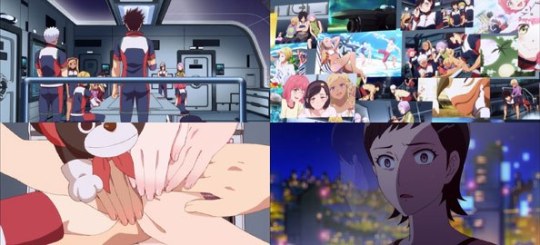
The crew decides that the world can’t go on living with a false history, but understands that telling the world the wrong way could be disastrous, not just to them but to the world.
Ulgar suggests they contact a trustworthy police lieutenant, and an detailed message is sent to him through Aries’ mom, including photos and videos of the still very much alive crew of Camp B5 and the log Aries has been making throughout the show (a nice touch).

By the time the Astra reaches orbit of Planet Astra, Lt. Grace is already at work arresting the King of Vixia, as well as his successor for his role in Princess Seira’s murder. Nothing a cop likes more than a bonanza of hard evidence. Very satisfying to watch these jerk-ass crooks made to pay for their heinous crimes.

The kids are met by an armed fleet in orbit, but after a few tense moments, contact is made and they identify themselves as friendly escorts, reporting that their originals have been apprehended and they are free to land. This is one of those instances where the extra length really counts, as we get to savor the crew’s arrival home and their ship’s final landing.
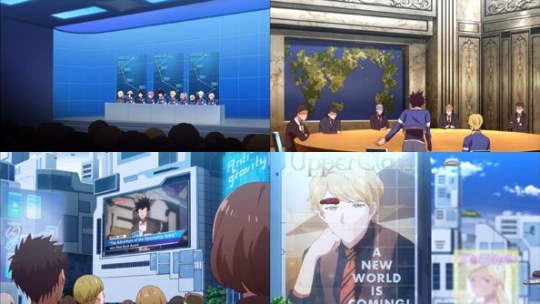
Once they arrive, and they get to tell their story to every media outlet on the planet, the crew become instant celebrities. Kanata and Charce tell the higher authorities about the need to spread the truth, something the higher-ups ultimately go with.
That bitter pill of truth is washed down without excessive unrest due in no small part to the charm of the crew, including the humanizing memoir about their five-month odyssey written by Kanata…not to mention the modelling chops of Quitterie and King Charce.

The length of the episode not only means it gets to take its time with a happy ending, but jumps seven years into the future, when the bulk of the crew is now 24. Everyone has changed their look a bit, but remain themselves and more importantly, remain good friends with one another, as you’d expect from what they went through. Yunhua sings a song inspired by those experiences, which essentially plays the series out.
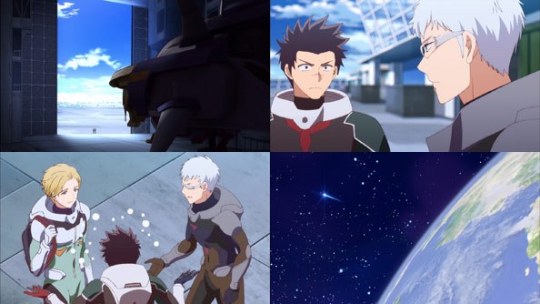
Quitterie is married to Zack, while Funi is in high school and looks just like Quitterie (and has Polina as a teacher). Ulgar is now a serious journalist, while Kanata has achieved his goal of becoming a captain in seven years. His new ship is his old ship; buying the over 100-year-old Astra with funds earned from his book and fame.
With his past and present trusty mates Zack and Charce, they take off to chart the exit points of the wormholes and beyond, but they’ll be back. After all, Charce has kingly duties to get back to; Zack has a wife to get back to, and Kanata has to get back to Aries so they can marry and have a daughter they can name Seira.
And there you have it: Kanata no Astra, not just an epic survival story of a group of extraordinary kids, but herald to a bold new truth for humanity. One could say almost too much befell these kids; that they’re too special. But to that I say…what do you expect? They are, after all, the clones of people rich and powerful and ambitious enough to, well, clone themselves.
They were always destined for greatness, but it wasn’t going to be given to them; they were literally left for dead. But their originals made one critical blunder, forgetting about the presence of one last ship in old Earth’s orbit, the chariot of their downfall and their clones’ salvation. In the end, the clones surpassed their originals to become entirely different people—better people.
People who, rather than lying and cheating and stealing their way through life, scratched and tore and screamed to break the bonds of their origins, united together in love and fellowship, and changed the goddamned world. Hell of a story if you ask me.

By: braverade
0 notes
Text
How to Convince Your Boss to Send You to MozCon 2019
Posted by cheryldraper
From networking with your peers to hearing from industry leaders, there are benefits a-plenty to attending conferences. You know that. Your peers know that. But how do you persuade the powers-that-be (aka your boss) that sending you is beneficial for your business?
To help convince your boss that won’t just be lounging pool-side, sipping cocktails on the company dime, we’ve gathered the goods to help you get your boss to greenlight your MozCon attendance.
How to make the case
Business competition is fiercer than ever. What used to make a splash now feels like it’s barely making ripples. Only those who are able to shift tactics with the changing tides of marketing will be able to come out on top.
And that’s exactly what MozCon is going to help you do.
Covering everything a growing marketer needs for a well-balanced marketing diet (SEO, content, strategy, growth), MozCon delivers top-notch talks from hand-selected speakers over three insightful days in July.
There’s so much in store for you this year. Here’s just a sampling of what you can expect at this year’s MozCon:
Speakers and content
Our speakers are real practitioners and industry leaders. We work with them to ensure they deliver the best content and insights to the stage to set you up for a year of success. No sales pitches or talking heads here!
Networking
You work hard taking notes, learning new insights, and digesting all of that knowledge — that’s why we think you deserve a little fun in the evenings. It’s your chance to decompress with fellow attendees and make new friends in the industry. We host exciting evening networking events that add to the value you’ll get from your day of education. Plus, our Birds of a Feather lunch tables allow you to connect with like-minded peers who share similar interests.
High-quality videos to share with your team
About a month or so after the conference, we’ll send you a link to professionally edited videos of every presentation at the conference. Your colleagues won’t get to partake in the morning Top Pot doughnuts or Starbucks coffee (the #FOMO is real), but they will get a chance to learn everything you did, for free.
An on-going supportive group
Our MozCon Facebook group is incredibly active, and it’s grown to have a life of its own — marketers ask one another SEO questions, post jobs, look for and offer advice and empathy, and more. It’s a great place to find TAGFEE support and camaraderie long after the conference itself has ended.
Great food on site
We know that conference food isn’t typically worth mentioning, but at MozCon is notorious for its snacking. You can expect two hot meals a day and loads of snacks from local Seattle vendors — in the past we’ve featured a smorgasbord from the likes of Trophy cupcakes, KuKuRuZa popcorn, Starbucks’ Seattle Reserve cold brew.
Swag
No duds here, we do our homework when it comes to selecting swag worthy of keeping. One-of-a-kind Roger Mozbots, a super-soft t-shirt, and more cool stuff you’ll want to take home and show off.
Wear your heart on your sleeve
MozCon and our attendees give back each year through donating Moz dollars towards a charitable organization.
Discounts for subscribers and groups
Moz Pro subscribers get a whopping $500 off their ticket cost and there are discounts for groups as well, so make sure to take advantage of savings where you can!
Ticket cost
At MozCon our goal is to breakeven, which means we invest all of your ticket prices back into you. Check out the full breakdown of what your MozCon ticket gets you:
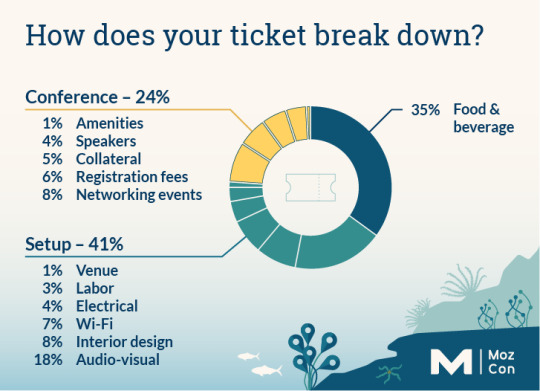
But of course, don’t take our word for it! There are some incredible resources available at your fingertips that tout the benefits of attending conferences:
Bizzabo’s 5 reasons to send your staff to industry events
HubSpot’s statistics showing the value of meeting face-to-face and networking
Rand’s excellent deep-dive into the reasons for and against attending marketing conferences
The ROI of investing in employee education
I’m convinced, now grab my ticket!
Need a little more to get your boss on board? Check out some videos from years past to get a taste for the caliber of our speakers. We’ve also got a call for community speaker pitches (closes at 5 pm PDT on April 15, 2019) so if you’ve been thinking about breaking into the speaking circuit, it could be an amazing opportunity.
Buy ticket, save money, get competitive marketing insights. Everyone wins!
MozCon is one unforgettable experience that lives and grows with you beyond just the three days you spend in Seattle. And there’s no time like the present to pitch MozCon to your boss. If they’re still stuck on the “why”, let them know about our subscriber or group pricing tiers to your boss — you’ll save hundreds of dollars when you do. Just think of all the Keurigs you could get for that communal kitchen!
Grab your ticket to MozCon!
Sign up for The Moz Top 10, a semimonthly mailer updating you on the top ten hottest pieces of SEO news, tips, and rad links uncovered by the Moz team. Think of it as your exclusive digest of stuff you don’t have time to hunt down but want to read!
from https://dentistry01.wordpress.com/2019/04/11/how-to-convince-your-boss-to-send-you-to-mozcon-2019/
0 notes